Oregon is known for both its natural wonders and its exciting cities – as well as its incredible wildlife!
Whether you live in Oregon or are just visiting, you always have the chance to see some incredible animals and birds in this state.
Did you know that Oregon is home to the Great Gray Owl, California Mountain King Snake, Rocky Mountain Bighorn Sheep, Humboldt’s Flying Squirrel, Coastal Marten, Burrowing Owl, Sea Otter, Black Bear, Gray Wolf, Cougar, Steller Sea Lion, and countless other creatures?
Birders love Oregon for its plentiful birdlife. The state actually has more than 500 individual bird species that have been identified within its 36 counties. That places Oregon high on the list for the most bird species in the nation!
Oregon doesn’t just have songbirds, raptors, and gulls: it also has ducks! Many different kinds of ducks!
There are at least 27 different kinds of ducks that can be found in Oregon. Some are year-round residents, while others routinely migrate through the area or live here in either the breeding or non-breeding season.
Yet others are just accidental migrants who have only been spotted a few times!
To help you learn more about the ducks in Oregon, we’ve put together a convenient list of the 27 ducks you may see in the state.
But first, we need to differentiate between the two basic groupings of ducks: dabblers and divers. Both can be found in Oregon’s waters.
What’s a Dabbling Duck, Anyway? And a Diving Duck?
Ducks fit into one of two categories, based entirely on their foraging and hunting behaviors.
They are either Dabbling Ducks (also called puddle ducks) or Diving Ducks (also called sea ducks).
Dabbling Ducks don’t go completely underwater when they forage; they just flip themselves face-first into the water, leaving their little tails sticking straight up into the air on the surface.
Diving ducks, on the other hand, submerge themselves completely to gain access to food at the bottom of deeper waters.
To help you differentiate between these two kinds of ducks, we’ve labeled each bird in our list as either a dabbler or a diver.
Ready to get started? Here are the ducks you may see in Oregon!
American Wigeon (Dabbling Duck)

- Mareca Americana
- Length: 16.5 – 23.2 in (42 – 59 cm)
- Weight: 19.1 – 46.9 oz (540 – 1330 g)
- Wingspan: 33.1 in (84 cm)
American Wigeons are winter-season ducks in Oregon, for the most part. Sometimes, they will stick around all year. They are often found in the Willamette Valley and elsewhere along the coast.
Their breeding territory includes Alaska, western Canada, and some parts of the northwestern US. Their winter territory includes Oregon and states along both the Pacific and Atlantic coasts. They are ground-nesters who lay up to 13 eggs in a clutch.
They prefer wetlands and ponds, and their diet includes insects, invertebrates, and aquatic vegetation.
Males are small, grayish-brown ducks with green stripes on each side of their heads. They have a pale bill and a white cap on their heads. In fact, the white cap is what gives them their nickname: “the baldpate.”
Females have brown bodies with grayish-brown heads. Their bills are also pale in color.
Barrow’s Goldeneye (Diving Duck)
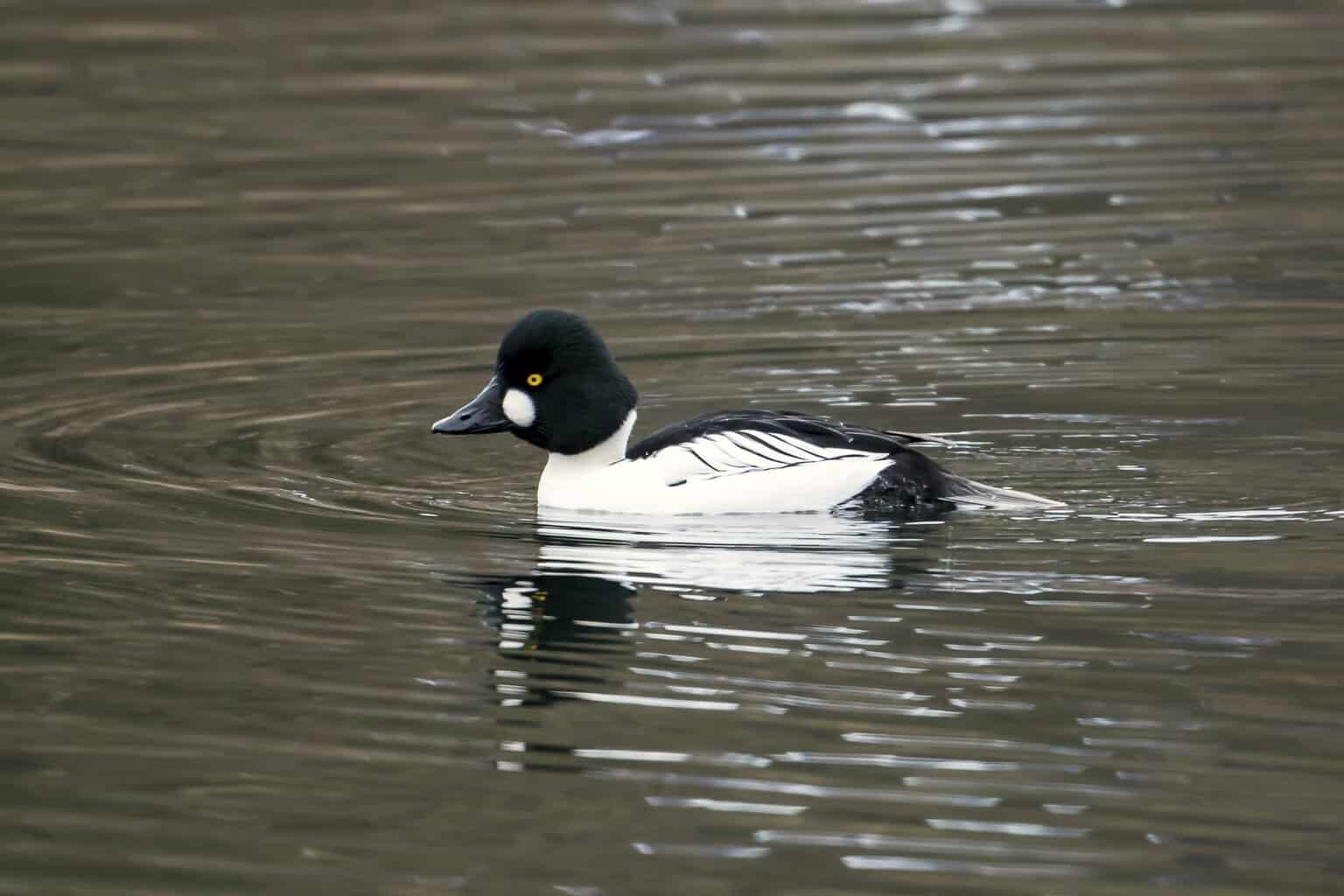
- Bucephala islandica
- Length: 16 – 20 in (41 – 51 cm)
- Weight: 38.4 oz (1088 g)
- Wingspan: 30 – 32 in (76 – 81 cm)
You’ll find Barrow’s Goldeneyes in the winter, typically between November and April. After that, they move on to far western Canada and Alaska.
Some people confuse Barrow’s Goldeneyes with Common Goldeneyes (who are coming up in this list!). Male Barrow’s Goldeneyes have very dark heads that are almost purple but look black from a distance. Behind their bill, they have a white, crescent-shaped patch on their cheek.
Females are gray with dark brown heads. The female’s bill is yellow-orange, and she has golden eyes like the male. She also has a white collar around her neck.
In Oregon, Barrow’s Goldeneyes live in the mountains, in both lakes and ponds.
They are cavity-dwellers, which means that they build their nests in the abandoned cavities of other birds and ducks. They like the holes left behind by woodpeckers, and they will even nest in cliffs and trees.
Interestingly, Barrow’s Goldeneyes choose waterways that have no insect-eating fish – because that would be too much competition for the same food!
Barrow’s Goldeneyes are definitely creatures of habit, so if you live in Oregon, you may be able to build a nest box and see the same pair of ducks return year after year.
Black Scoter (Diving Duck)
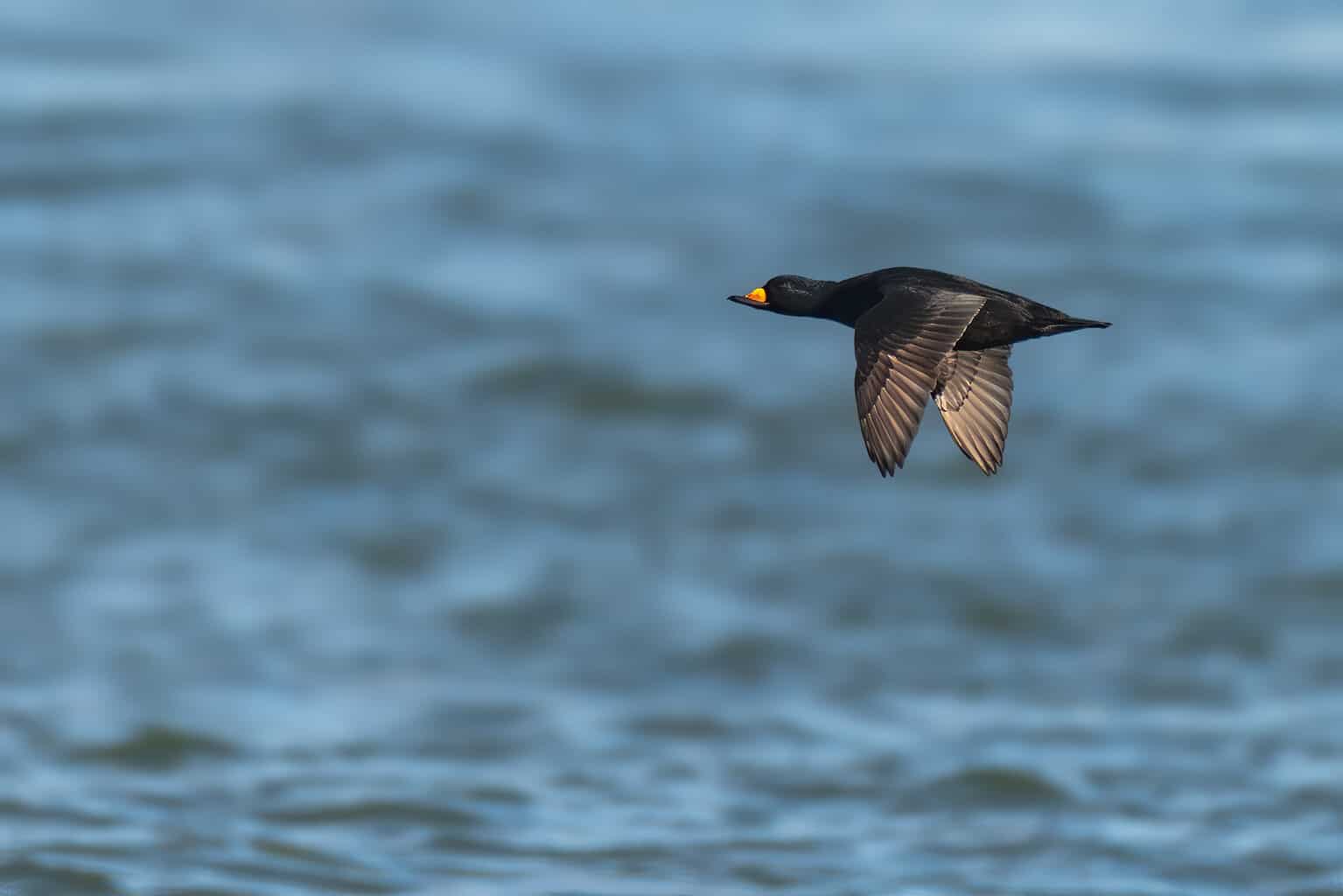
- Melanitta Americana
- Length: 127 – 21 in (43 – 53 cm)
- Weight: 387.4 oz (1088 g)
- Wingspan: 30 – 35 in (76 – 89 cm)
Black Scoters are not a common sight in Oregon, as they are categorized as “near-threatened”. If you do see some of these all-black ducks, you’re probably along the coast between October and March.
Well, let’s be more precise: Males are all black, with a bright, pumpkin-orange bulb at the base of the bill. Females are brown with a dark brown crown and black bill.
The breeding territory of the Black Scoter includes Alaska and Canada. They migrate to the US coastal waters for the fall and winter.
Black Scoters like rocky coastlines and they often gather in huge groups – sometimes they flock with thousands of other Scoters.
Their diet is made up of shellfish and ocean mollusks, as well as shrimp and other shellfish. If they are in freshwater where they can’t get shellfish and mollusks, they will eat fish eggs, fish larvae, and aquatic vegetation.
Blue-Winged Teal Duck (Dabbling Duck)
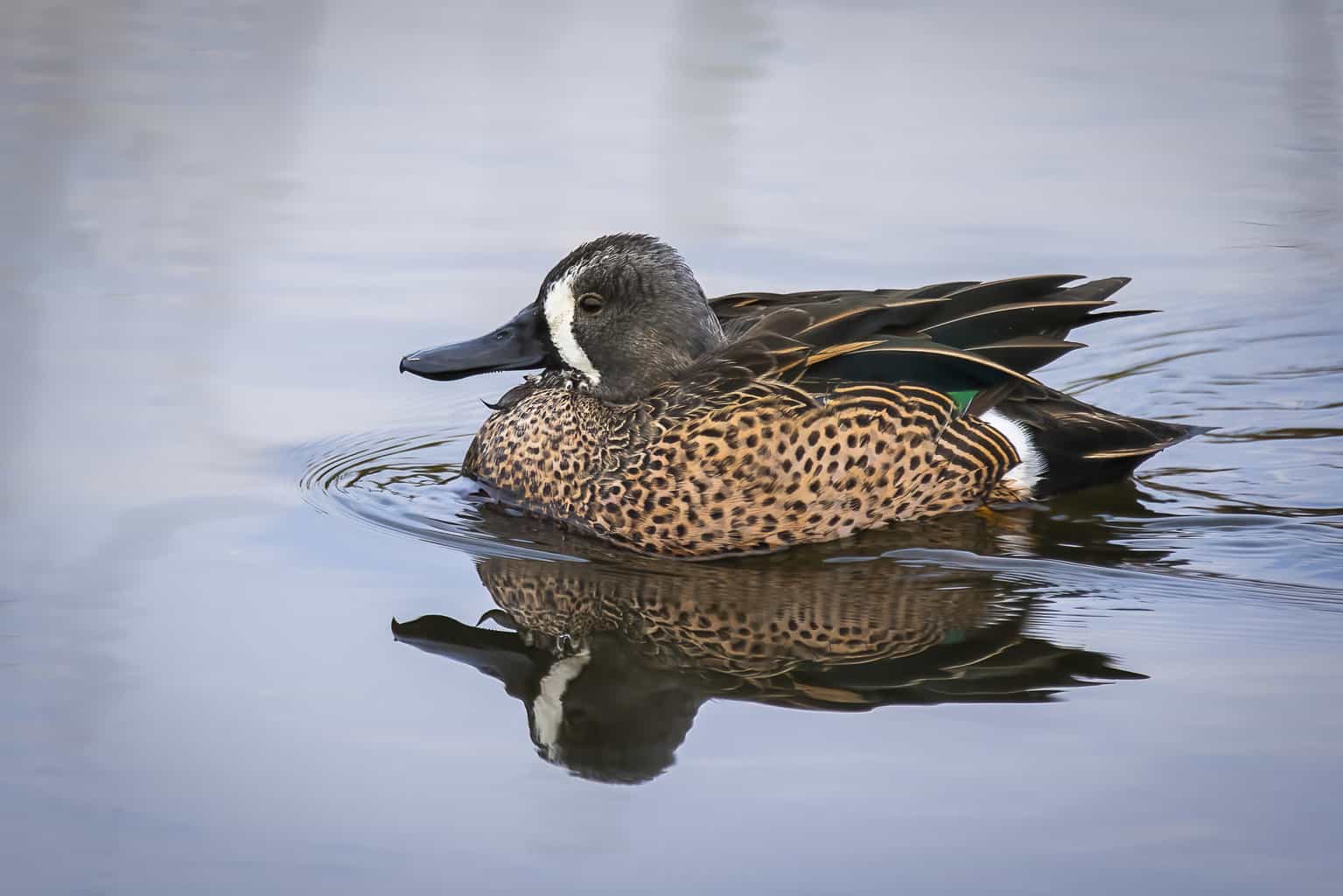
- Spatula discors
- Length: 15 – 17 in (38 – 43 cm)
- Weight: 19.18 oz (544 g)
- Wingspan: 23 -31 in (58 – 79 cm)
Your best chance to see a Blue-Winged Teal Duck in Oregon is in the summer breeding season; specifically, they are present in the state between April and October.
They are more likely to be spotted in the eastern half of the state, but they do inhabit some waters along the coast.
They are early migrants in the fall, but late migrants in the spring.
Males are small and have blueish-gray heads, brown spots on most of their body, and a white crescent shape on the face, in front of their eyes. They have a blue shoulder patch and a green speculum.
Females are spotted, but they lack the white crescent on the face.
Their diet is primarily made up of aquatic plants and insects. They prefer to live in calm waters, especially ponds where there is plenty of aquatic vegetation.
Unfortunately, Blue-Winged Teal Ducks have high mortality rates – higher than any other dabbling duck.
Bufflehead (Diving Duck)
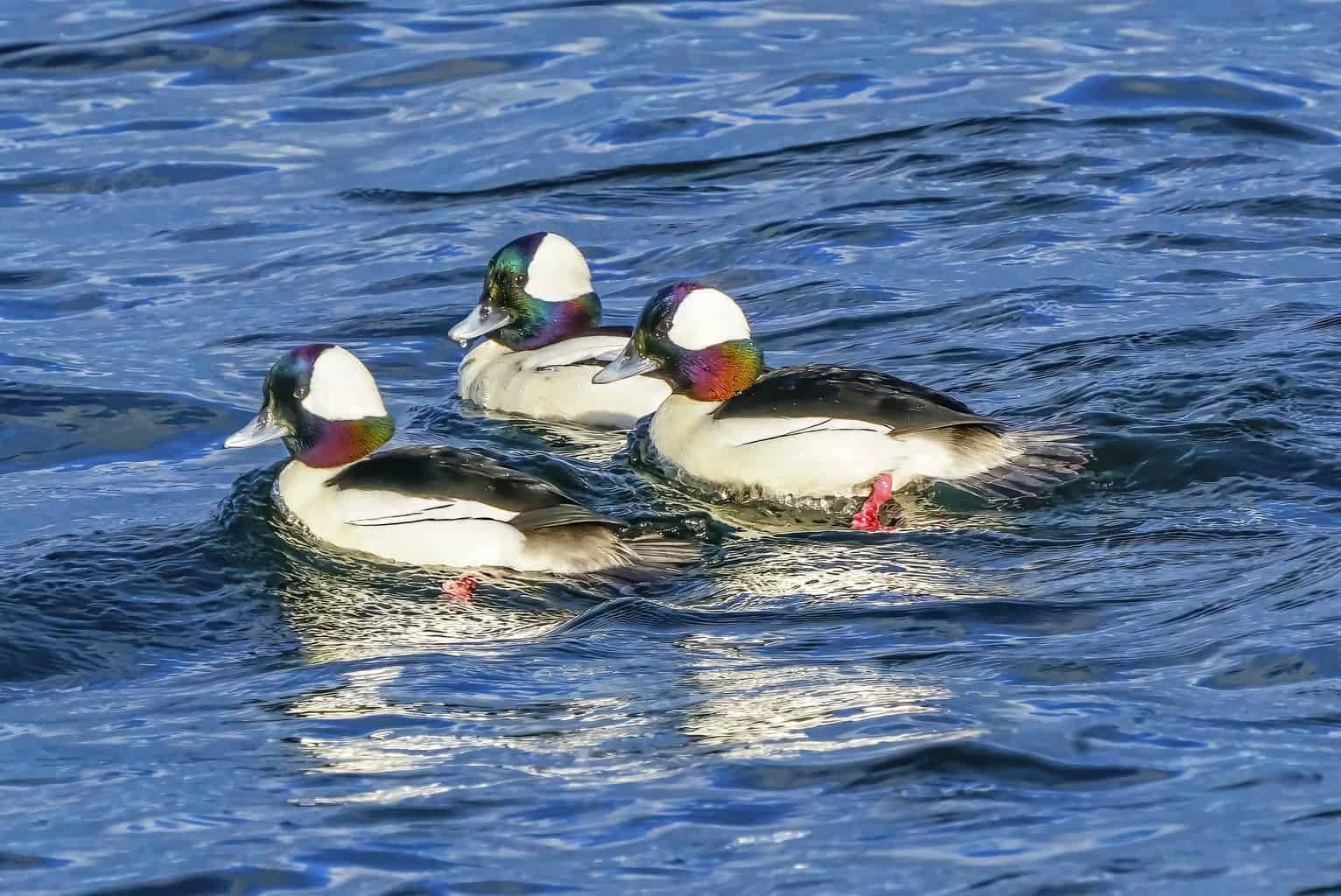
- Bucephala albeola
- Length: 13 – 16 in (33 – 41 cm)
- Weight: 21.16 oz (600 g)
- Wingspan: 20 – 24 in (51-61 cm)
The Bufflehead gets its name from its big, fluffy, round head. Both males and females have this head shape, but otherwise, they have little in common in their appearance.
Males have a big white patch right behind their eyes; they also have shiny green and purple heads, white bodies, and black backs. Females have dark brown heads, plus a white patch below the eyes. Their bodies are gray and black.
Buffleheads are cavity dwellers who make their home throughout Oregon in the winter. A few stick around all year.
They are monogamous, choosing one mate for many years at a time, so you’ll usually see them in pairs.
Their primary habitat is small ponds and inland lakes in forests that are partially coniferous and deciduous.
If you want to increase your chances of seeing Buffleheads in Oregon, you can build them a nest box! Check out this PDF for instructions on how to build an ideal duck nesting box.
Canvasback (Diving Duck)
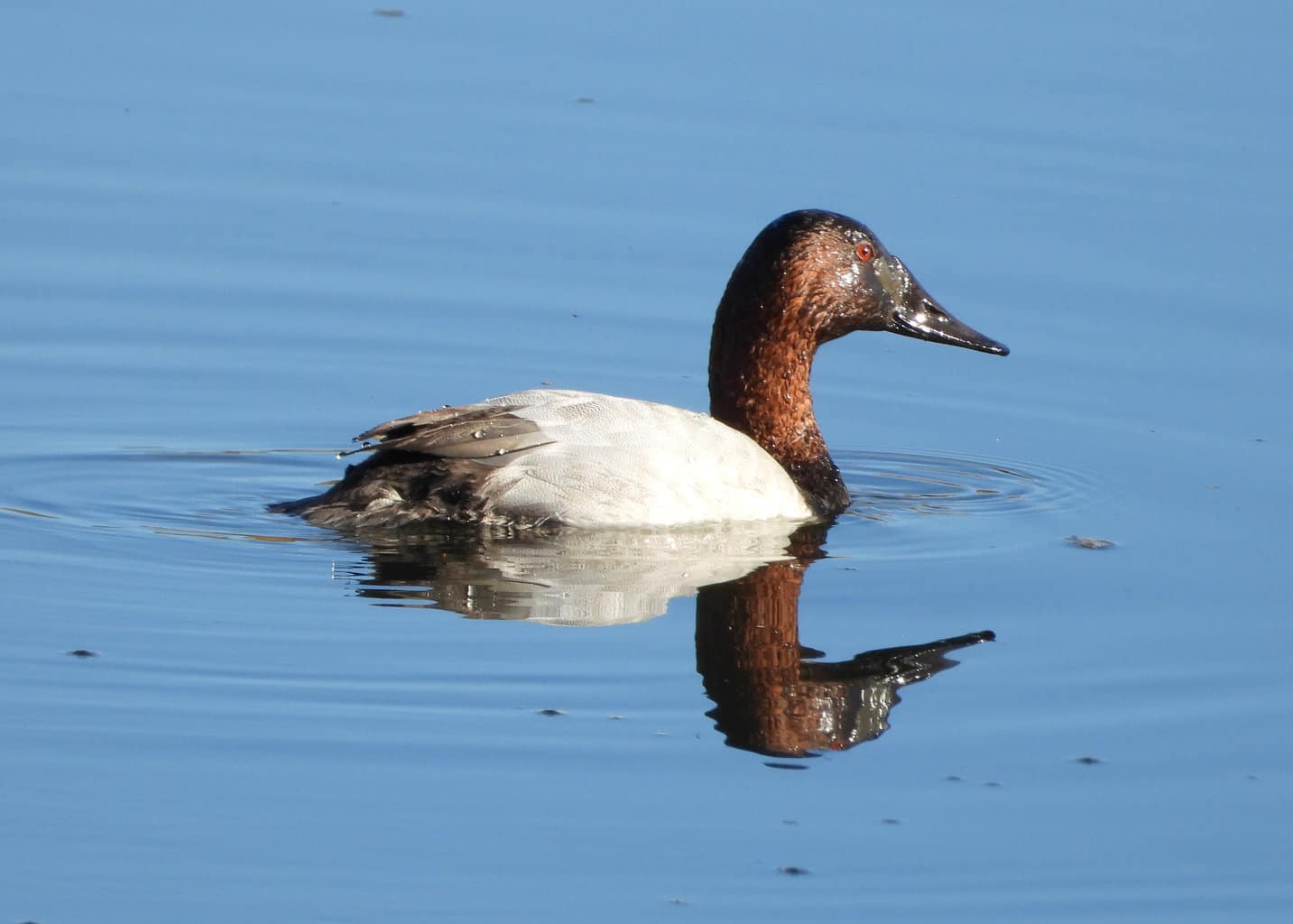
- Aythya valisineria
- Length: 19 – 24 in (48 – 61 cm)
- Weight: 58.48 oz (1657 g)
- Wingspan: 28 – 36 in (71 – 91 cm)
It’s not difficult to identify a male Canvasback at just a glance. He has a rich, dark copper-colored head, black chest, and light gray body. The female has a similar pattern, but their coloring is much lighter. She has dark black eyes, whereas he has red eyes.
Canvasbacks typically overwinter in Oregon, arriving in October and not leaving until May, when they leave to spend the breeding season in western Canada.
Canvasbacks are known for building incredibly durable nests. It makes sense that their nests are so bulky, as these are also the largest diving ducks in North America.
They choose Oregon’s bays and marshes for their winter habitat. Essentially, if there is plenty of aquatic vegetation and invertebrates, it’s a great place for them to spend these cold months, being expert diving ducks.
Cinnamon Teal Duck (Dabbling Duck)
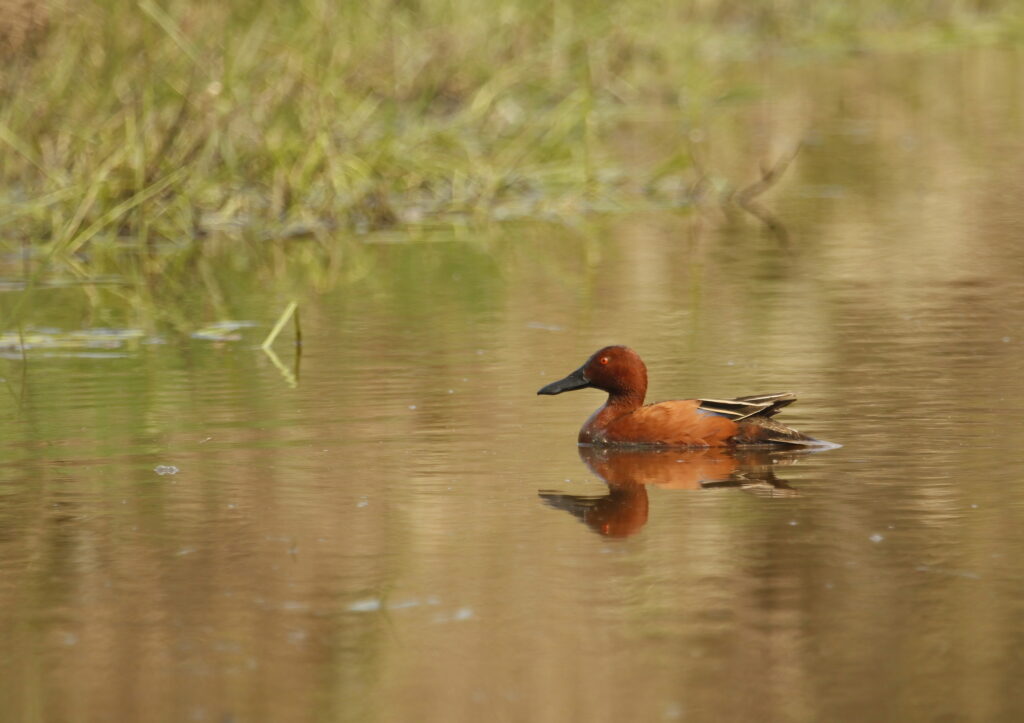
- Spatula cyanoptera
- Length: 14- 17 in (36 – 43 cm)
- Weight: 16.4 oz (465 g)
- Wingspan: 24 – 30 in (61 -76 cm)
In the breeding season, male Cinnamon Teal Ducks are incredibly vibrant and breathtaking ducks. They are reddish-orange from top to bottom, including their red eyes. A pale blue shoulder and green speculum stand out against the burnt-cinnamon color of the rest of their bodies.
By winter, they look similar to females, who have a scaled pattern across their chest and most of their body.
Cinnamon Teals are year-round residents in Oregon. They are most plentiful between April and October and are more likely to be in the eastern half of the state. They prefer shallow, alkaline lakes, including freshwater ponds.
Unlike monogamous ducks that stick with the same partner for years, Cinnamon Teal Ducks choose a new partner every year.
Common Merganser (Diving Duck)
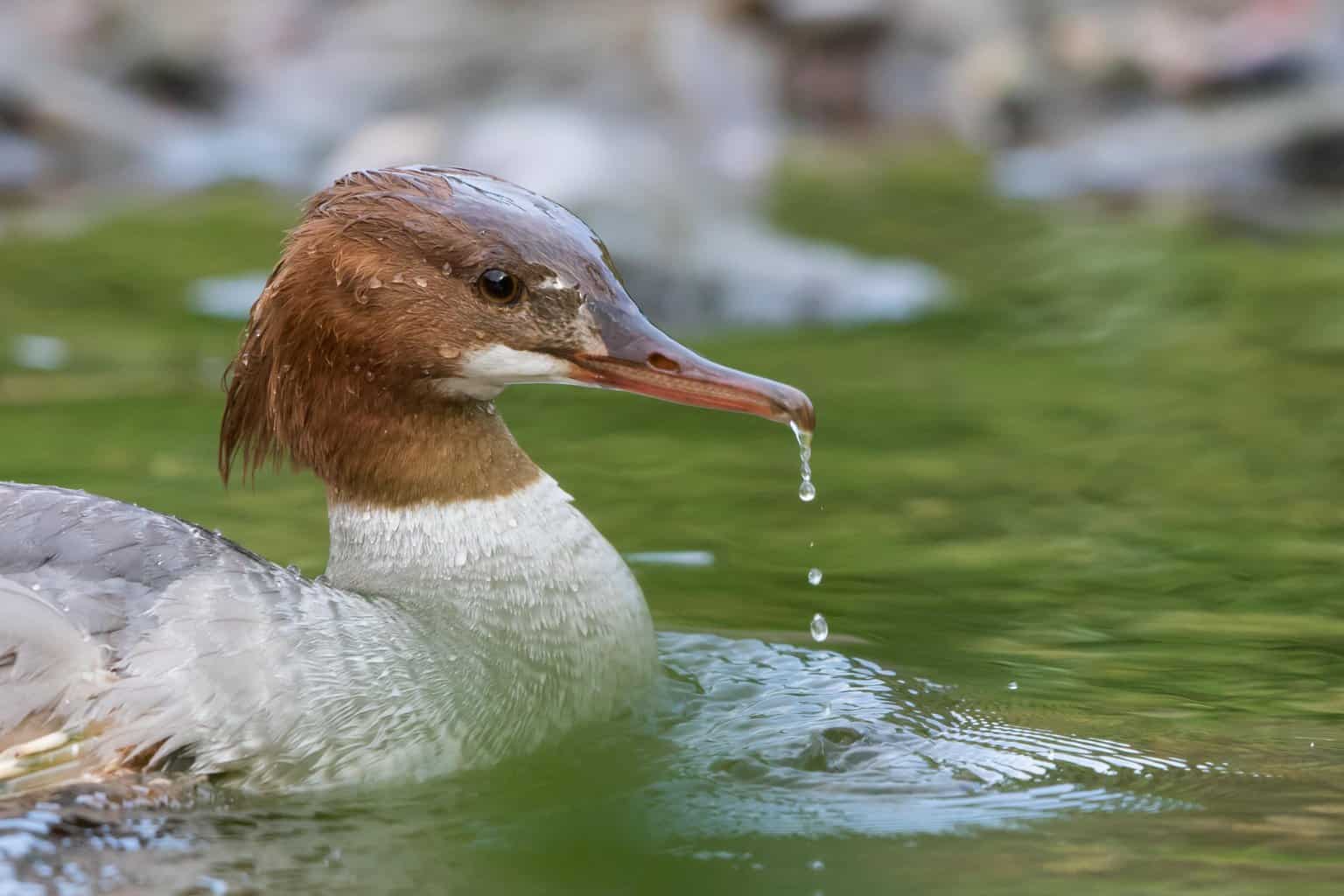
- Mergus merganser
- Length: 22 – 27 in (56 – 69 cm)
- Weight: 60.8 oz (1723 g)
- Wingspan: 31 – 37 in (79 – 94 cm)
Meet the flashy Common Merganser!
Male Common Mergansers have greenish-black heads, black eyes, and a bright red bill, as well as a crest that is only sometimes visible. The crest on the cinnamon-red head of the female is much more visible. She has a white patch on her chin, a white breast and belly, and a gray black.
Both male and female Common Mergansers have a serrated bill, which they use to rip apart the fish that they catch under the water.
In Oregon, Common Mergansers are most common between October and March.
They are tree cavity dwellers who live in mature forests, but they will also nest in nest boxes and along the cliffside. Their preferred habitat is a freshwater pond, lake, or small river.
Common Mergansers are very independent birds, from the moment they’re born. They hatch and immediately leave the nest and start foraging for food. Their mother may help them find some food, but for the most part, they are on their own!
Eurasian Wigeon (Dabbling Duck)
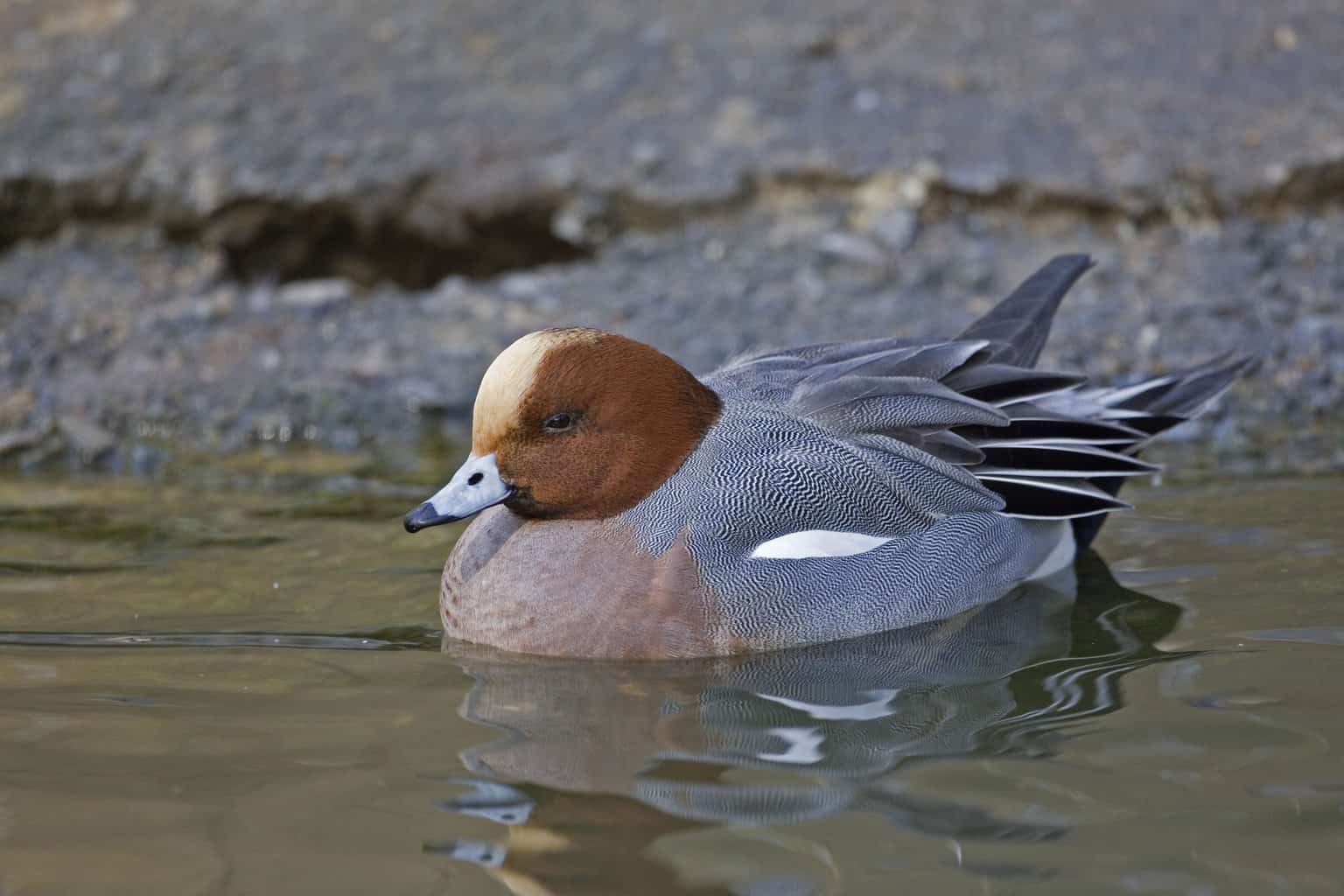
- Mareca penelope
- Length: 18 – 20 in (46 – 51 cm)
- Weight: 35.27 oz (1000 g)
- Wingspan: 30 – 32 (76 – 81 cm)
Eurasian Wigeons are not common outside of Northern Europe and Russia, but they sometimes migrate to North America from eastern Russia.
If you’re lucky enough to see one in North America, you’re probably in Oregon! If they end up here, it’s a great winter habitat for them, especially as they thrive in the same environments as American Wigeons.
Eurasian Wigeon males have a creamy white patch on the front of their coppery heads. Their bodies are covered in tiny black and white barring, and they have a blue bill with a black tip.
Females, though, are mostly brown or gray. Their heads are speckled in dark and light brown.
Eurasian Wigeons live along tidal flats, marshes, lakes, and flooded grasslands. They are accomplished thieves who frequently steal food from the bills of other ducks in the same territory.
Although many ducks are cavity-dwellers, Eurasian Wigeons build nests in shallow holes in the ground. They are shielded by tall grasses.
Gadwall (Dabbling Duck)
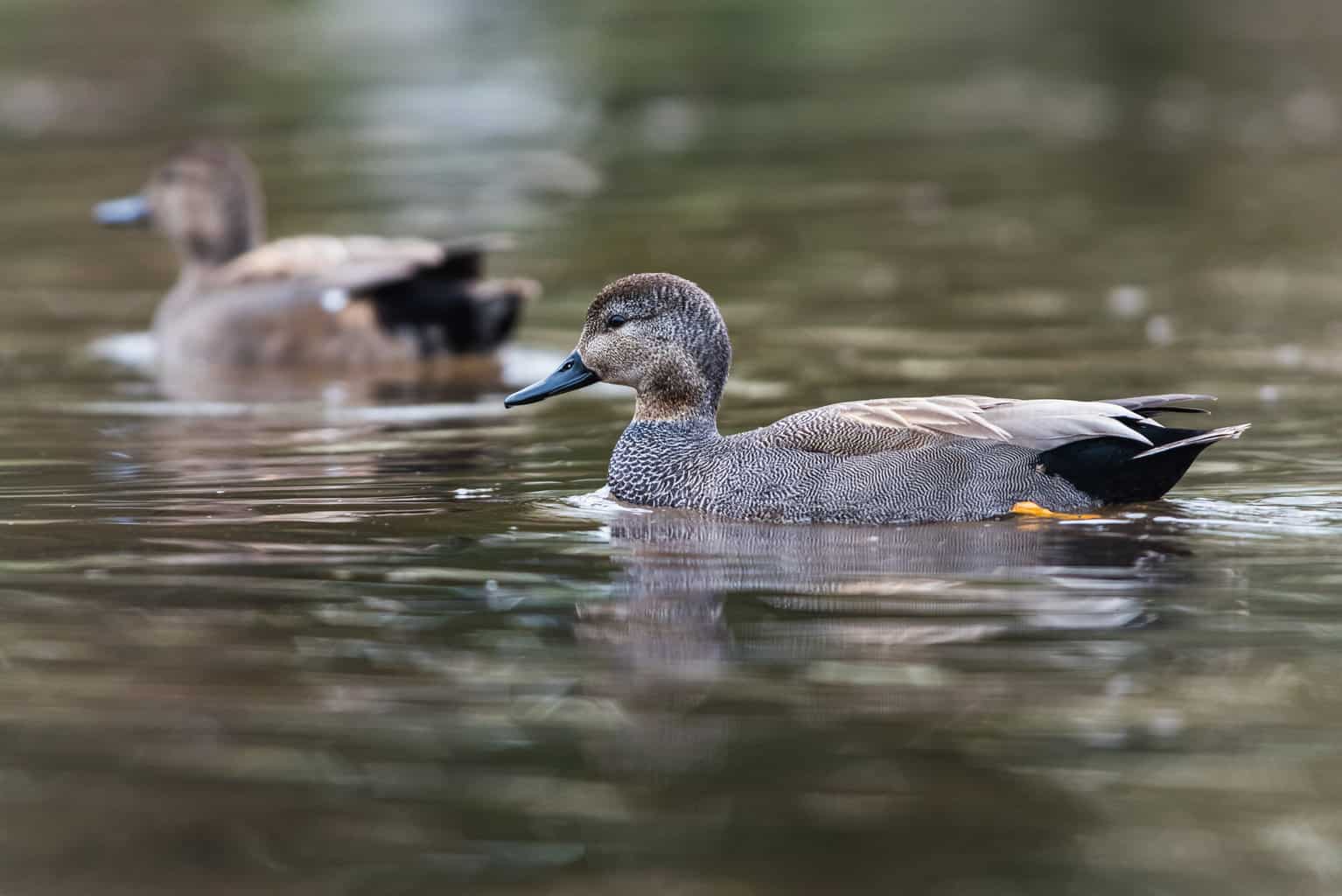
- Mareca strepera
- Length: 19 – 23 in (48 – 58 cm)
- Weight: 35.27 oz (1000 g)
- Wingspan: 31 – 36 in (79 – 91 cm
Gadwalls are incredibly common ducks in Oregon. As year-long residents, they are most commonly found in eastern Oregon. Sometimes, they’ll breed in western Oregon as well.
These ducks are less attention-grabbing than other, more colorful ducks. In a reversal of the typical pattern, male Gadwalls are more muted in color than females. Males are light brown and white, with a scaled pattern over most of their body. Females are darker brown and off-white.
Gadwalls prefer open wetland territories, including flooded grasslands and marshes. Their winter territory includes saltwater marshes and city parks.
They are excellent at hiding among the tall grasses near the water. Thanks to their muted coloring and their ability to hide, it takes quite a lot of effort to see a Gadwall in person.
Greater Scaup (Diving Duck)
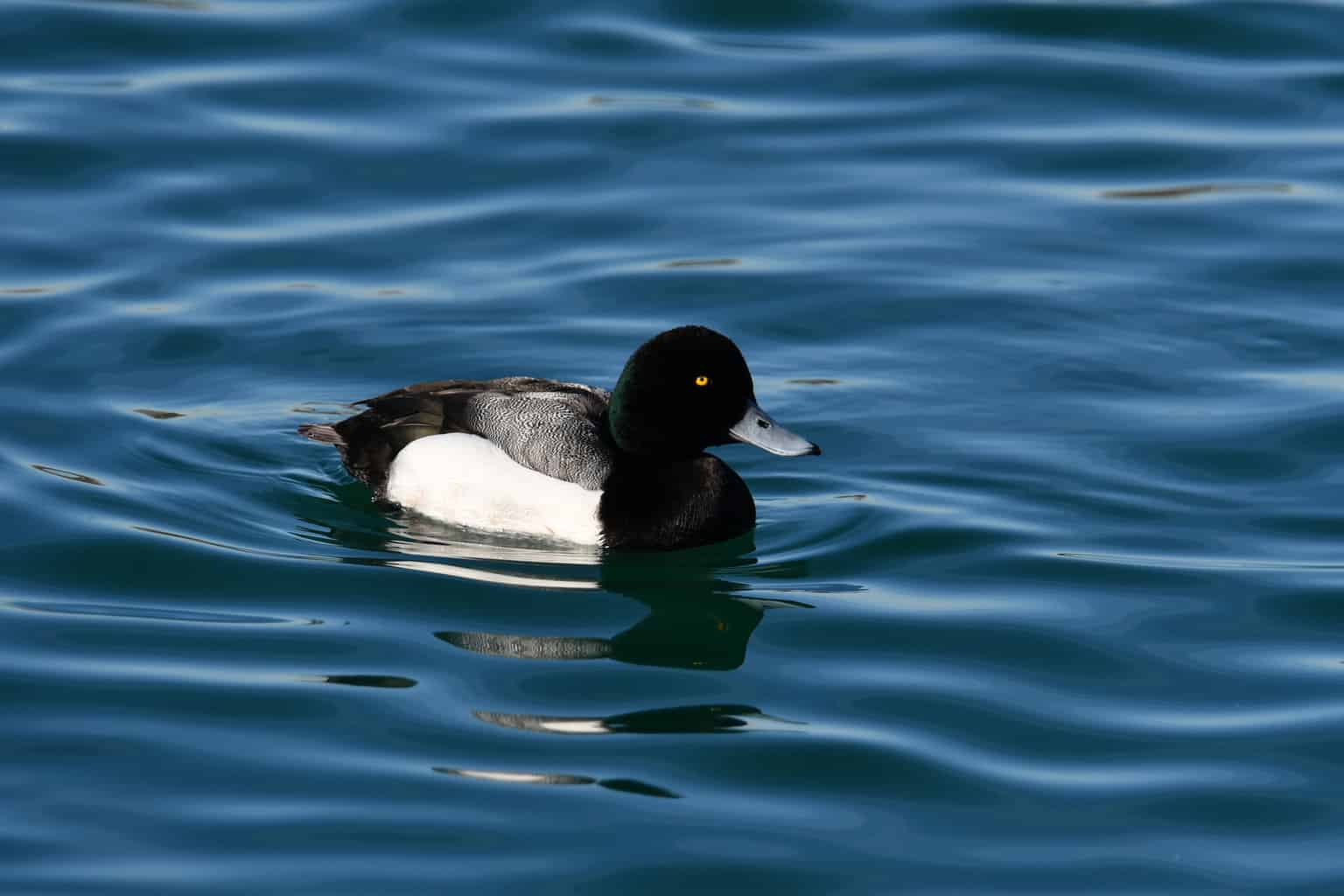
- Aythya marila
- Length: 15.3 – 22.1 in (39 – 56 cm)
- Weight: 25.6 – 48.0 oz (726 – 1360 g)
- Wingspan: 28.4 – 31.1 in (72 – 79 cm)
Greater Scaup are sometimes confused with Lesser Scaup, but with one big difference: their heads are much rounder.
During the breeding season, male Greater Scaup have a metallic green head, gray-and-black barred back, blue bill, and white sides. Their winter appearance leaves them with a gray and brown body and a head that loses its iridescent sheen.
The female is brown-bodied, with a dark head and a big white patch near the bill.
Greater Scaup are found in shallow ponds and lakes during the breeding season, but their winter territory includes Oregon’s coastal waters.
These ducks are impressive divers who can go as deep as 23 feet underwater to pursue their food!
Green-Winged Teal Duck (Dabbling Duck)
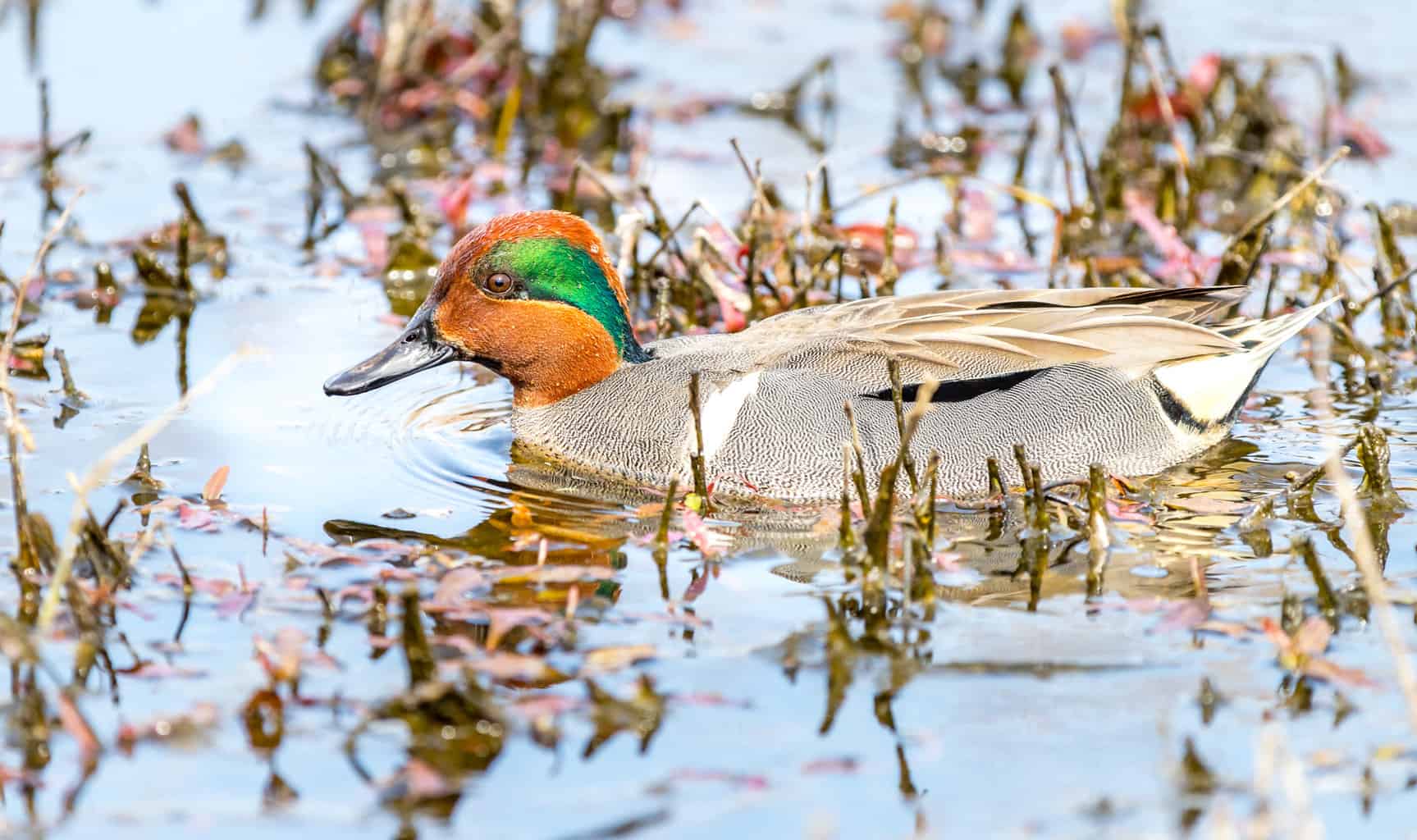
- Anas crecca
- Length: 12.2 – 15.3 in (31 – 39 cm)
- Weight: 4.9 – 17.6 oz (140 – 500 g)
- Wingspan: 20.5 – 23.2 in (52 – 59 cm)
Green-Winged Teal Ducks are quite small. Males are recognizable from the green stripe that runs from the eyes to the back of the head. Females are brown, but they have a unique characteristic: a yellow streak that runs alongside their tails.
Both sexes boast a flashy green speculum.
You’ll find Green-Winged Teal Ducks in Oregon all year, especially in the winter. They live along mountain streams and along the rocky coast.
Groups of Green-Winged Teal Ducks will number in the tens of thousands. They lay their nests on the ground.
Here’s an interesting fact about Green-Winged Teal Ducks: they can take off directly from the water, rather than needing to get a running start.
Harlequin (Diving Duck)
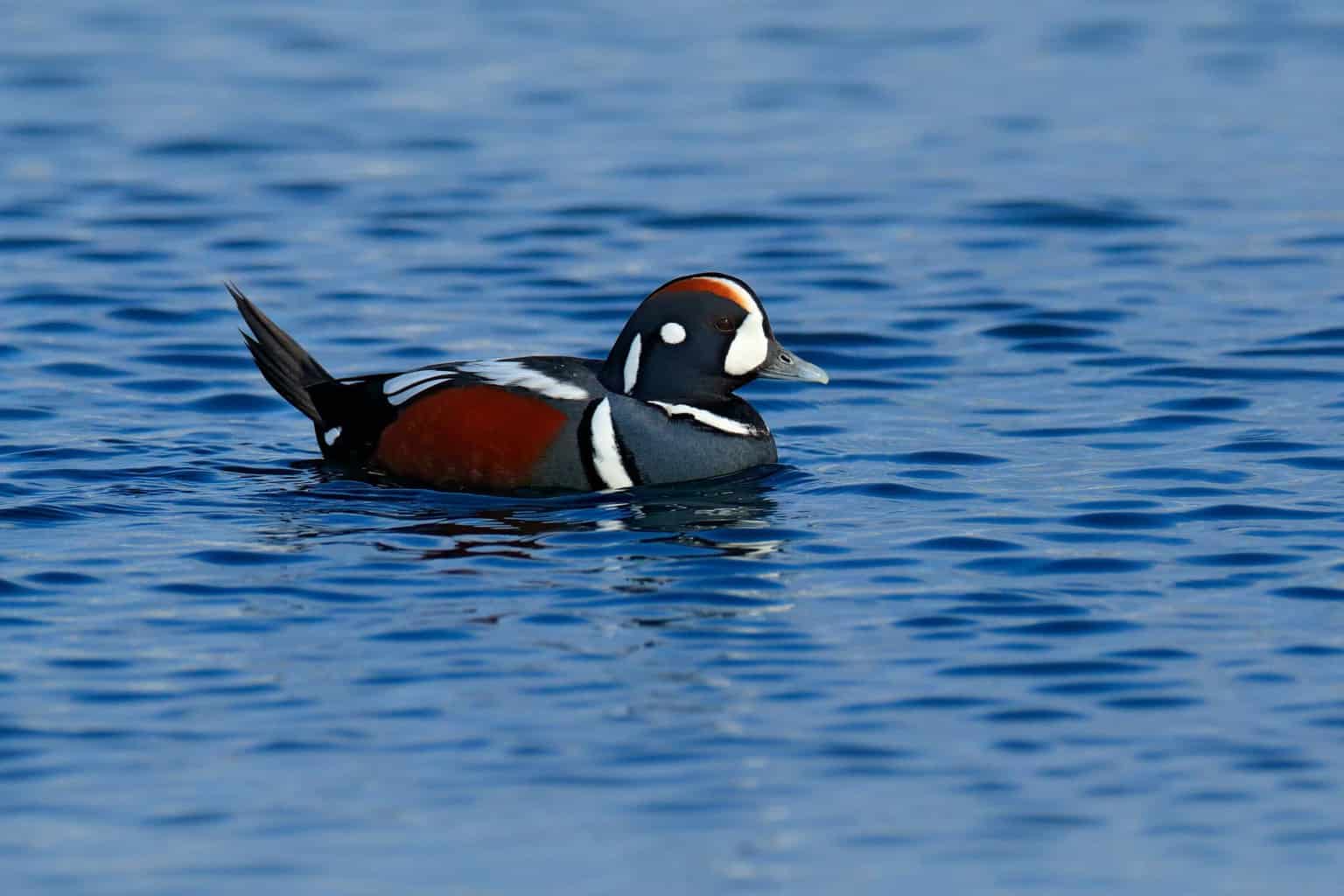
- Histrionicus histrionicus
- Length: 15 – 21 in (38 – 53 cm)
- Weight: 24 oz (680 g)
- Wingspan: 26 – 28 in (66 – 71 cm)
Harlequin Ducks are little sea ducks with incredibly dramatic coloring. Breeding males are mostly slate blue, but they have white stripes on their neck, chest, and head. Those stripes are lined in black. They also have some reddish-brown on their body: on their sides and along the top of their head.
Females are almost entirely brown, but they do have a small white patch near the back of the head.
Harlequins are great swimmers who live in rough and turbulent waters. The huge waves often smash them against the rocks, which is why they have been found to have recovered from many broken bones and head injuries.
The Harlequin Duck is nicknamed the Sea Mouse. Though they are small, the nickname actually comes from the mouse-like sound that they make, not their size.
Hooded Merganser (Diving Duck)
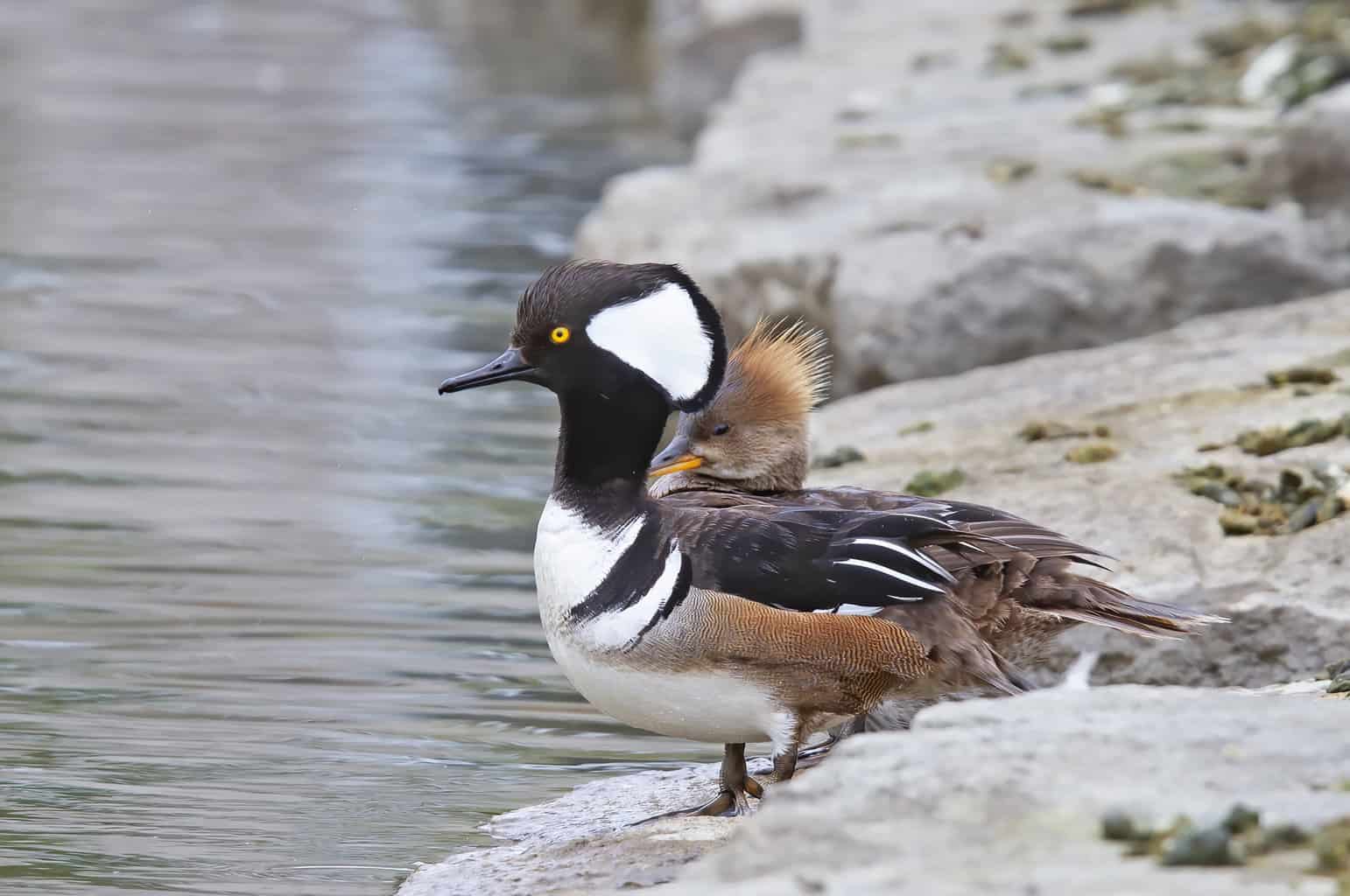
- Lophodytes cucullatus
- Length: 16 – 19 in (41 – 48 cm)
- Weight: 32.09 oz (909 g)
- Wingspan: 24 – 26 in (61 – 66 cm)
Oregon’s coast makes it a great place for year-round ducks like the Hooded Merganser.
Although Hooded Mergansers are more common in Oregon in the winter (typically November-March), they can also be seen year-round in the state.
Hooded Mergansers are the only kind of Merganser species that lives only in North America.
These small ducks have an interesting trait: males can raise or lower their crest, thus changing the apparent shape of their heads. The male’s head is black and white, and his crest looks like a large white fan when extended. When lowered, it is just a thin line.
Males are light brown on their sides, but black and white on the rest of their body, including black bars on the chest.
Females are also crested, but their coloring is totally different. They are cinnamon-brown.
In addition to the fascinating crest, Hooded Mergansers have another interesting trait: they sound like pickerel frogs croaking! This may not be their only vocalization, but it’s definitely the most noteworthy one. This sound gives them the nickname “frog duck.”
Hooded Mergansers are cavity dwellers who choose holes in trees as their nesting spaces. These holes can be up to 20 feet above the ground!
Even with such heights, baby Hooded Mergansers leap from the tree within 24 hours of hatching and start foraging for food.
Lesser Scaup (Diving Duck)
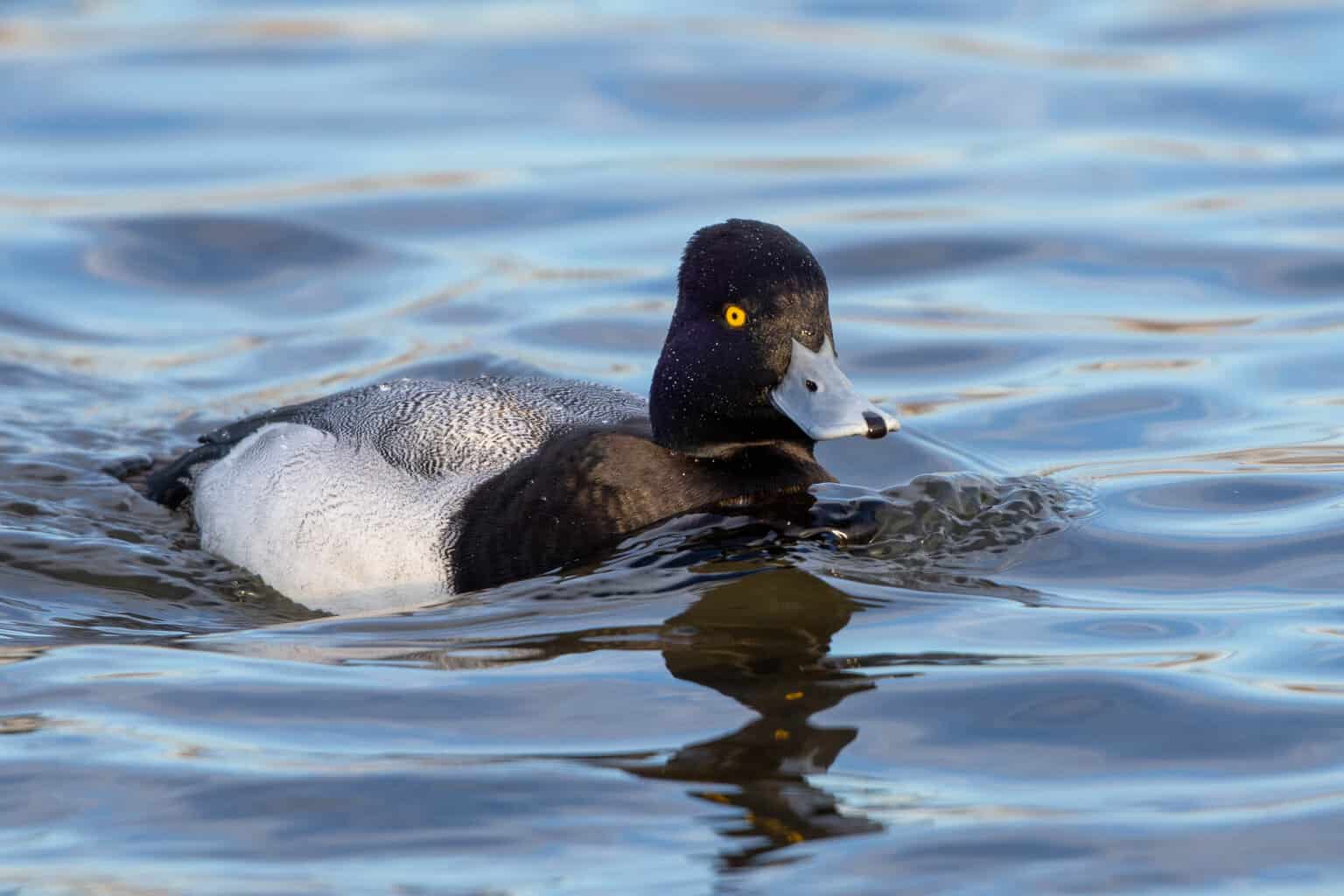
- Aythya affinis
- Length: 15 – 18 in (38 – 49 cm)
- Weight: 40.77 oz (1155 g)
- Wingspan: 24 – 33 in (61 – 84 cm)
Lesser Scaup look quite similar to Greater Scaup, but the biggest difference is that they have a few hairs on the top of their head, creating just the tiniest crest that Greater Scaup lack.
Lesser Scaup males have purplish-black heads, golden yellow eyes, white sides, and thin gray bars across most of the body. Females are dark brown, with a white patch on their faces.
These are ducks that overwinter in Oregon, although you may get lucky and see one during the breeding season, too.
Here’s a fascinating fact about the Lesser Scaup: they will pretend to be dead to escape a predator! This behavior is a survival mechanism that helps Lesser Scaup stay in the harsh environments where they live.
You’ll find Lesser Scaup in Oregon’s rivers, lakes, reservoirs, and ponds. Because they are most often here in winter, you’re likely to encounter them in large groups.
Long-Tailed Duck (Diving Duck)
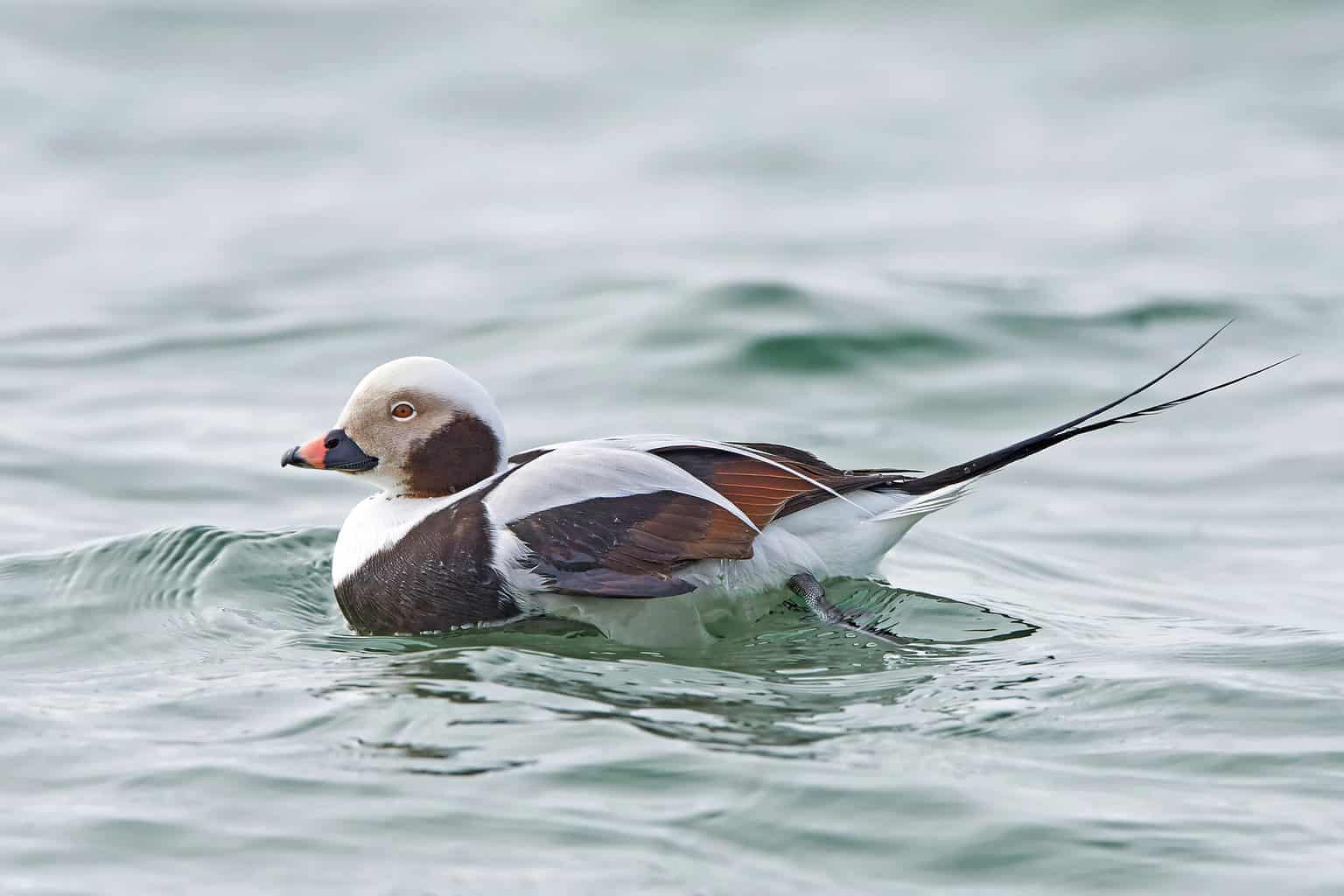
- Clangula hyemalis
- Length: 15 – 22 in (38 – 56 cm)
- Weight: 31.74 oz (900 g)
- Wingspan: 26 – 31 in (66 – 79 cm)
There are plenty of ducks whose appearance changes between the breeding and non-breeding season, but Long-Tailed Ducks may be the only ones whose colors literally reverse themselves between the seasons!
In the winter, the male Long-Tailed Duck has a lot of white on its body: the crown, forehead, neck, back, sides, and underside. He has a gray mask across his eyes and a dark black cheek patch, as well as a black breast and wings. His shoulders are white, and he has a long black tail (hence the name!).
Then, come summer, those colors switch. Any part of the duck that was black is now white, and the part that was white is now black. What an unusual and fascinating trait!
It’s not just the male who reverses his coloring. During the non-breeding season, females have a lot of brown on their bodies: throat, back, wings, and tail. Their head is white and they have a dark cheek patch. Then, come the breeding season, everything switches again, just like the male.
Long-Tailed Ducks are pretty rare in Oregon, but they have been observed along the coast.
They are spotted with more frequency in the winter, as they spend their summer in the far northern reaches of Canada, on the tundra.
They can dive as deep as 200 feet under the water to hunt zooplankton!
Mallard (Dabbling Duck)
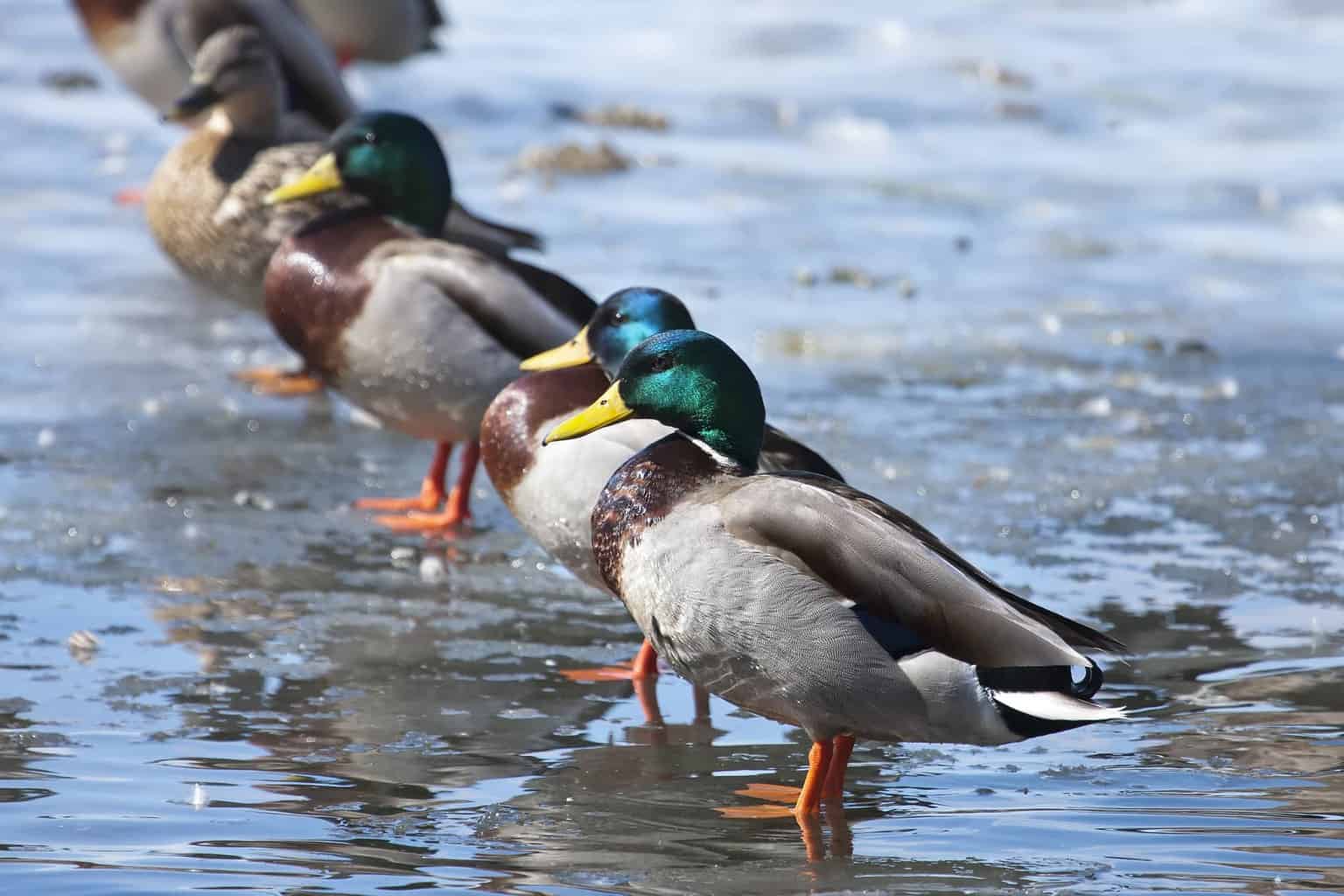
- Anas platyrhynchos
- Length: 19.7 – 25.6 in (50 – 65 cm)
- Weight: 35.3 – 45.9 oz (1000 – 1300 g)
- Wingspan: 32.3 – 37.4 in (82 – 95 cm)
Mallards are Oregon’s most common duck.
They are big, easily recognizable ducks, thanks to the iridescent green head of the male. The male Mallard also has a bright yellow bill and a gray body. His breast is brown, and he has a blue speculum.
Female Mallards have light brown speckled heads and a darker, streaked and mottled body.
You don’t have to be a birder to easily identify a Mallard, as these are some of the most easily recognized ducks in the world. They are also the ancestors of most domesticated ducks in North America.
In Oregon, you’ll find Mallards throughout the whole state. They nest close to the water, hidden among the tall grasses.
Mallards tend to be especially aggressive ducks. Their aggression is most obvious during the breeding season when they are competing for territory and mates. They will chase and attack each other, even ripping out feathers and skin.
Male Mallards are known for aggressive sexual behavior toward females, too. Many people find Mallards to be beautiful ducks that also exhibit behaviors that we, as humans, tend to see as troubling.
Northern Pintail (Dabbling Duck)
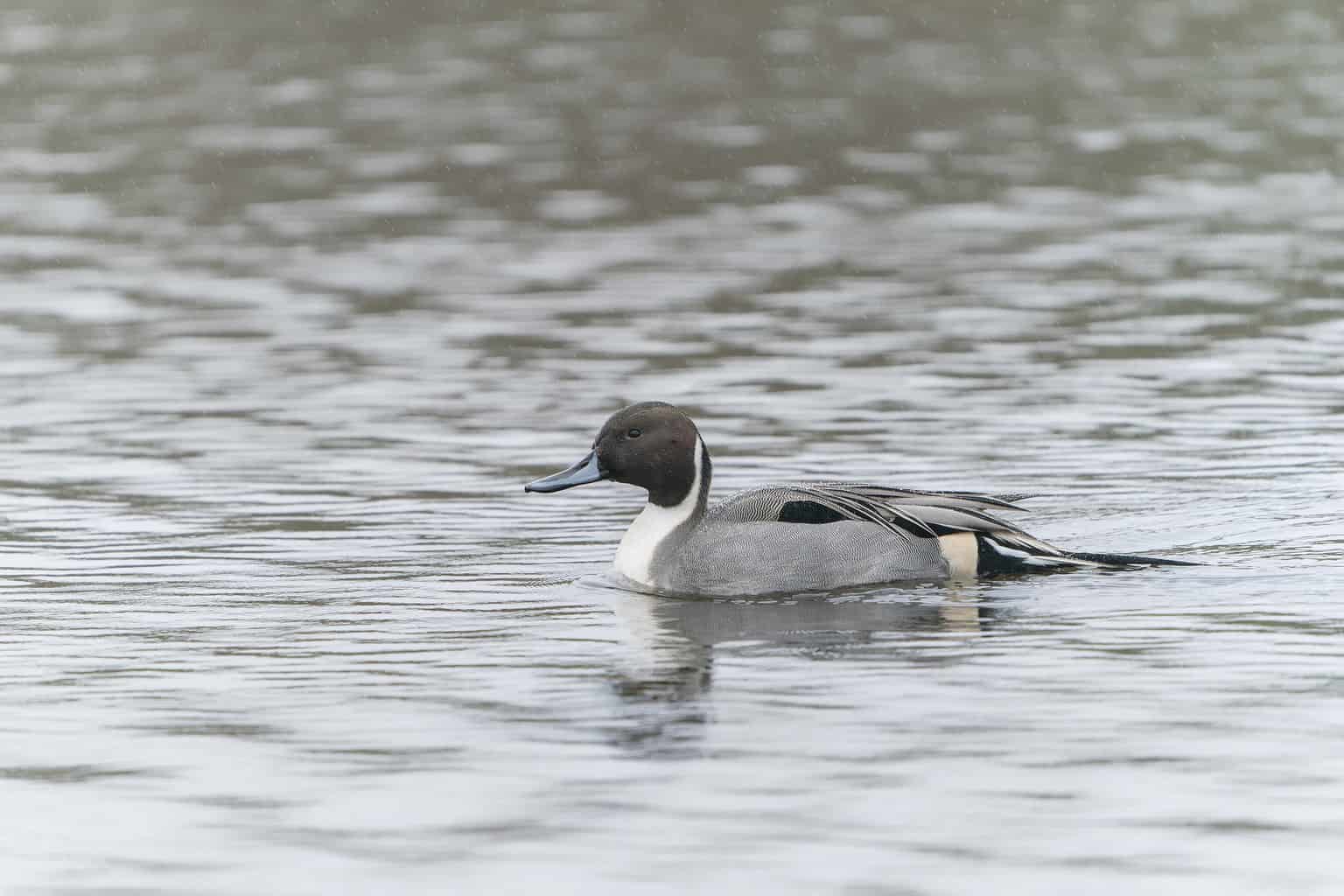
- Anas acuta
- Length: 20 – 26 in (51 – 66 cm)
- Weight: 36.33 oz (1030 g)
- Wingspan: 29 – 35 in (74 – 89 cm)
Northern Pintails are very fast ducks that can fly up to 48 miles per hour. They are so fast, in fact, that they are popular as a challenge for duck hunters.
These ducks have long, pointy tails that give them their name. Males are brown-headed and have a white stripe that runs down their necks. They have white bodies and gray, black, and white on their back, as well as a pretty, green speculum.
Females, by contrast, are intricately patterned with dark brown scales on a light brown body.
They are most frequently spotted in Oregon in the winter months, ranging from September to April. Their summer territory includes wetlands and marshes, but their winter territory is made up of coastal lagoons and estuaries.
Because Northern Pintails have longer necks than the average dabbling duck, they can reach much farther when they submerge their heads for food than their dabbling peers.
Northern Shoveler (Dabbling Duck)

- Spatula clypeata
- Length: 17.3 – 20.1 in (44 – 51 cm)
- Weight: 14.1 – 28.9 oz (400 – 820 g)
- Wingspan: 27.2 – 33.1 in (69 – 84 cm)
A male Northern Shoveler may have a green head like a Mallard, but there’s little confusion between these two ducks.
Northern Shovelers have an immediately identifiable bill that is broad, black, and incredibly wide. Sometimes it is described as “spoon-shaped” or “spatula-shaped,” and yes, it does give them their name.
Females have the same broad bill, but it is brown instead of black. Their body’s coloring is mottled brown. They have a blue patch on the shoulder.
Northern Shovelers prefer to spend their time in large groups. They like shallow, standing water, rather than open rivers or oceans. They are most commonly spotted in Oregon in the Willamette Valley and Columbia Basin, especially in the winter.
They are known for defecating on their eggs when they feel threatened. This habit may seem gross to us, but it is a strategy they use to protect their eggs from predators.
Red-Breasted Merganser (Diving Duck)
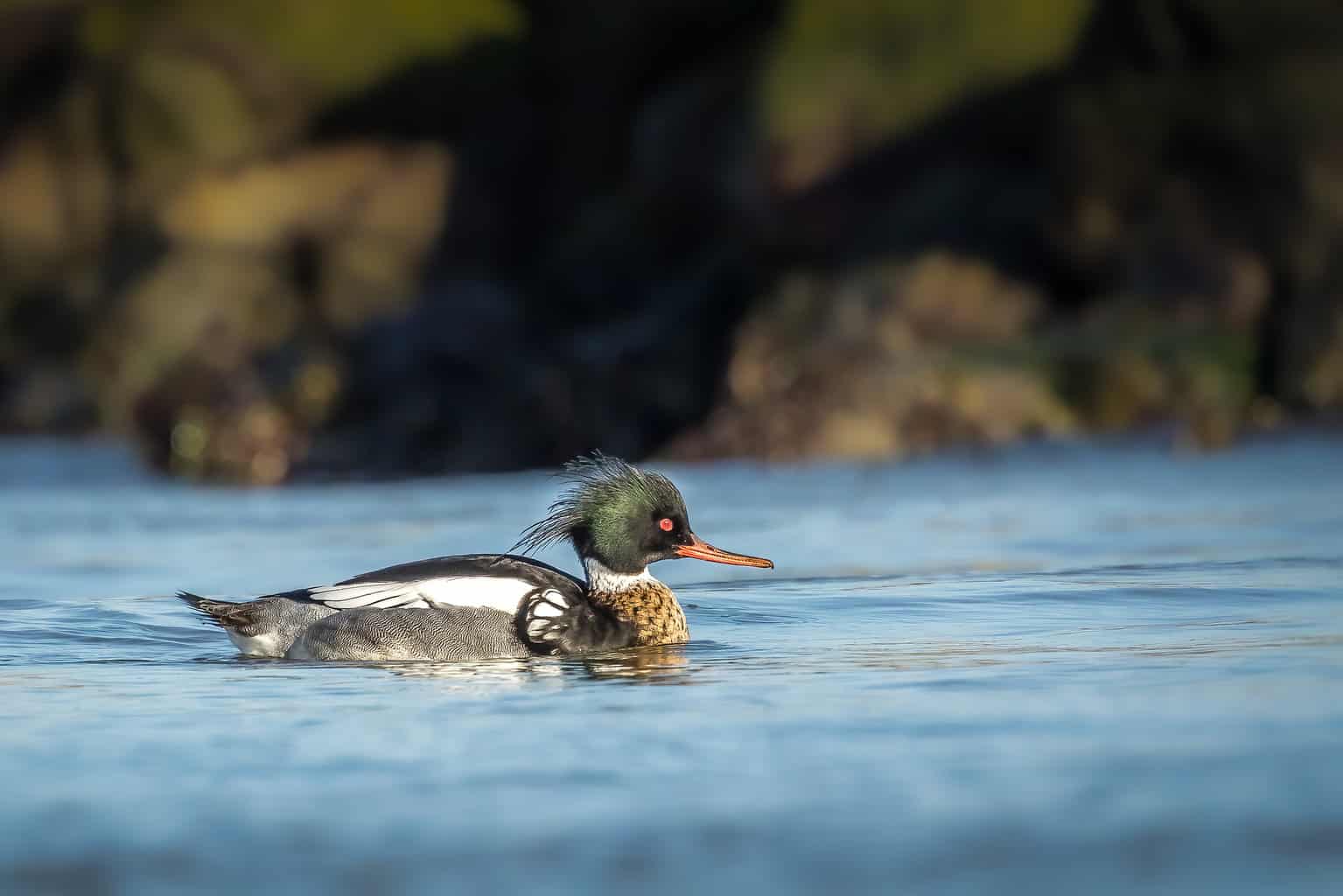
- Mergus serrator
- Length: 16 – 26 in (41 – 66 cm)
- Weight: 47.61 oz (1349 g)
- Wingspan: 31 – 35 in (79 – 89 cm)
You won’t miss the Red-Breasted Merganser!
Males have a flashy, shaggy crest on the top of their vibrant, green heads. They also have red eyes and a long, orange, serrated bill. The white ring around the neck separates the green head from the brownish-red chest.
They don’t reach sexual maturity until they are 2 years old.
Females have the same spiky, ragged crest and red eyes, but their heads are almost cinnamon-brown in color. They have white throats and gray bodies.
Red-Breasted Mergansers are in Oregon during the non-breeding season. They live along the coast, often in sheltered estuaries but also on the open sea. Because they live in such rough waters, they are rarely hunted by duck hunters, if only because they are so difficult to access.
You probably won’t come across a Red-Breasted Merganser nest, as they are excellent at camouflaging their nests in the grasses along the water.
Redhead (Diving Duck)
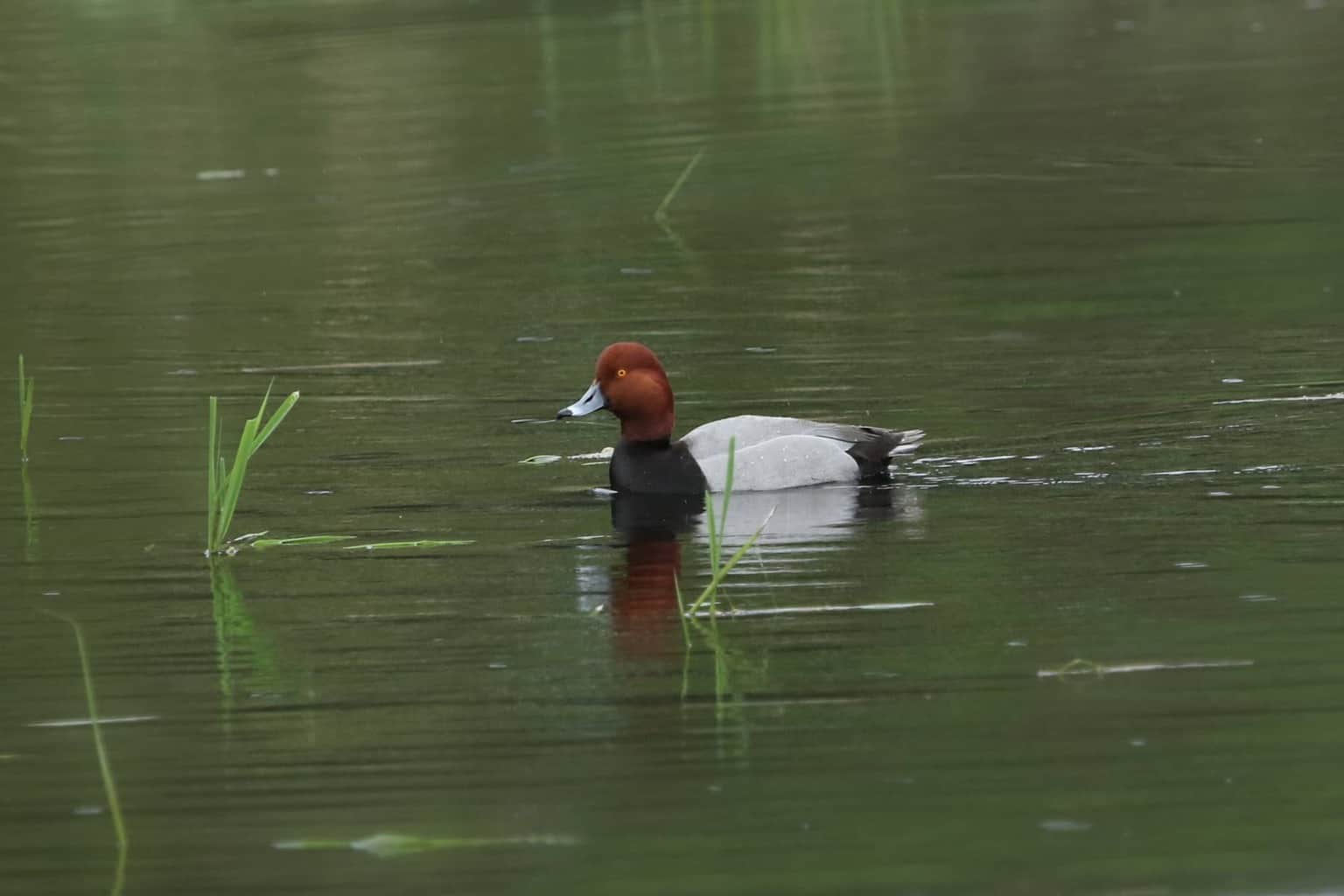
- Aythya americana
- Length: 18 -22 in (46 – 56 cm)
- Weight: 43.03 oz (1219 g)
- Wingspan: 29 – 35 in (74 – 89 cm)
It’s easy to know a Redhead when you see one. The male’s head is dark, coppery red, and his body is segmented in gray and black. His bill looks either gray or slate blue, depending on the light, and it is tipped in black.
Female Redheads are all brown, with minimal markings or patterns. They have the same bill as the males.
Redheads are found year-round throughout Oregon, especially in the eastern part of the state. They regularly inhabit Ladd Marsh, the Warner Wetlands, Summer Lake, and Malheur NWR.
During the winter, they are more likely to be found along the coast.
Redheads may participate in brood parasitism, which means they lay their eggs in the nests of other ducks. This allows them to lay a lot of eggs without having to raise the babies themselves.
However, they aren’t like Brown-Headed Cowbirds, who are exclusively parasitic. Plenty of Redheads raise their own young.
Ring-Necked Duck (Diving Duck)
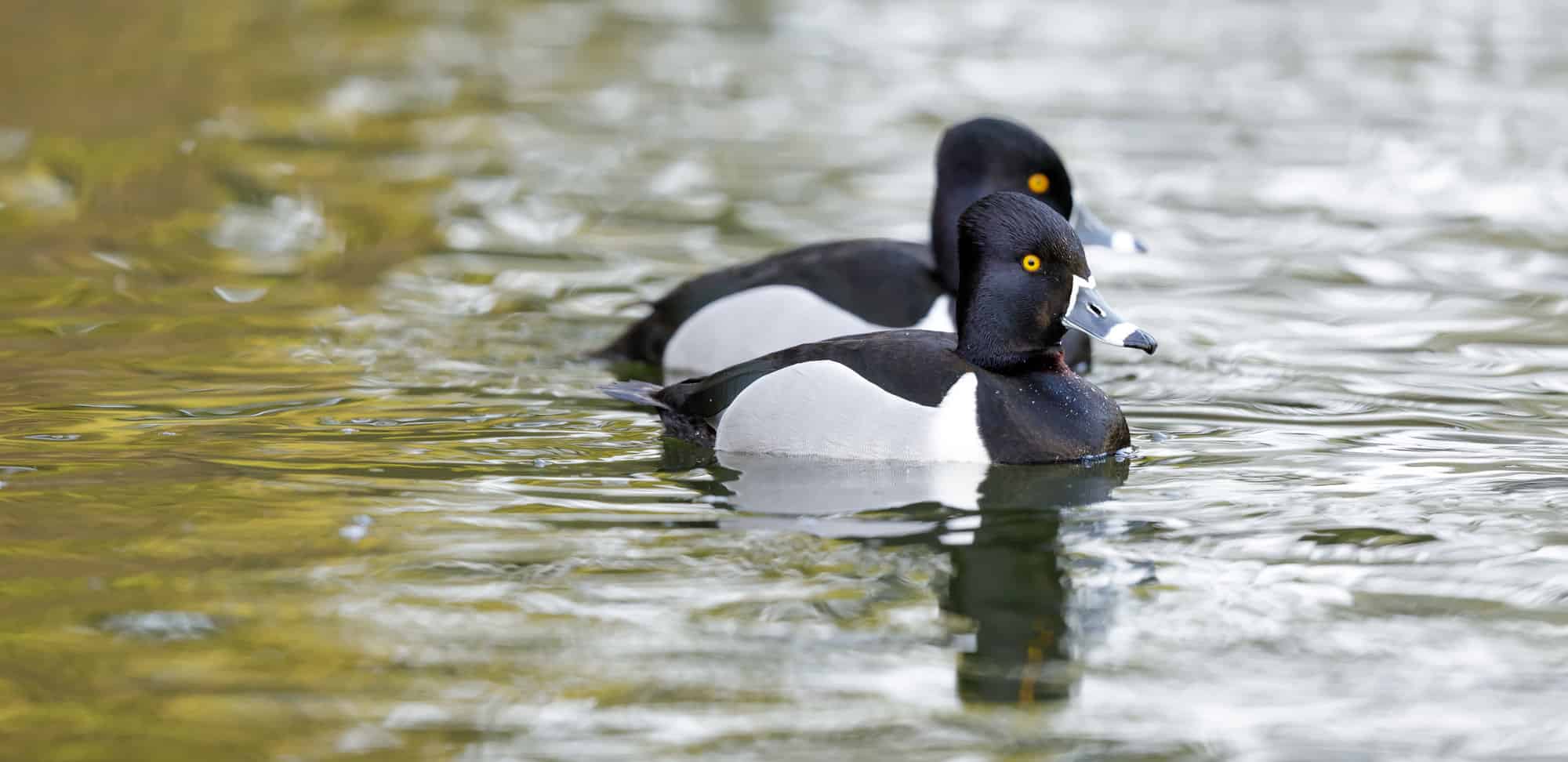
- Aythya collaris
- Length: 14 – 18 in (36 – 46 cm)
- Weight: 32.09 oz (909 g)
- Wingspan: 24 – 30 in (61 – 76 cm)
Ring-Necked Ducks spread across the western and southern US during the winter. Their summer migration takes them to central Canada.
There are always at least some of them in Oregon throughout the year, but they are most commonly found in the winter and during their fall and spring migration windows.
Despite the name, the Ring-Necked Duck doesn’t have much of a ring on its neck. Technically, there is a ring on its neck, but it’s hard to see.
The story is that it was named by naturalists in the 1800s who only handled dead specimens; perhaps it’s easier to see the copper ring on a duck that has already died!
Male Ring-Necked Ducks do have a white ring that goes around the base of the bill, as well as a thick white band near the tip of the bill. Males are white underneath, black on the chest and back, and black-headed. Their eyes are yellow.
Females have a brown body, gray face, and a thin white line that outlines their eyes. Females have the same white stripe across the bill, but no ring around the base of the bill.
In Oregon, you’ll find Ring-Necked Ducks in freshwater ponds and lakes, including Summer Lake. They prefer to nest in areas with heavy vegetation.
Ruddy Duck (Diving Duck)
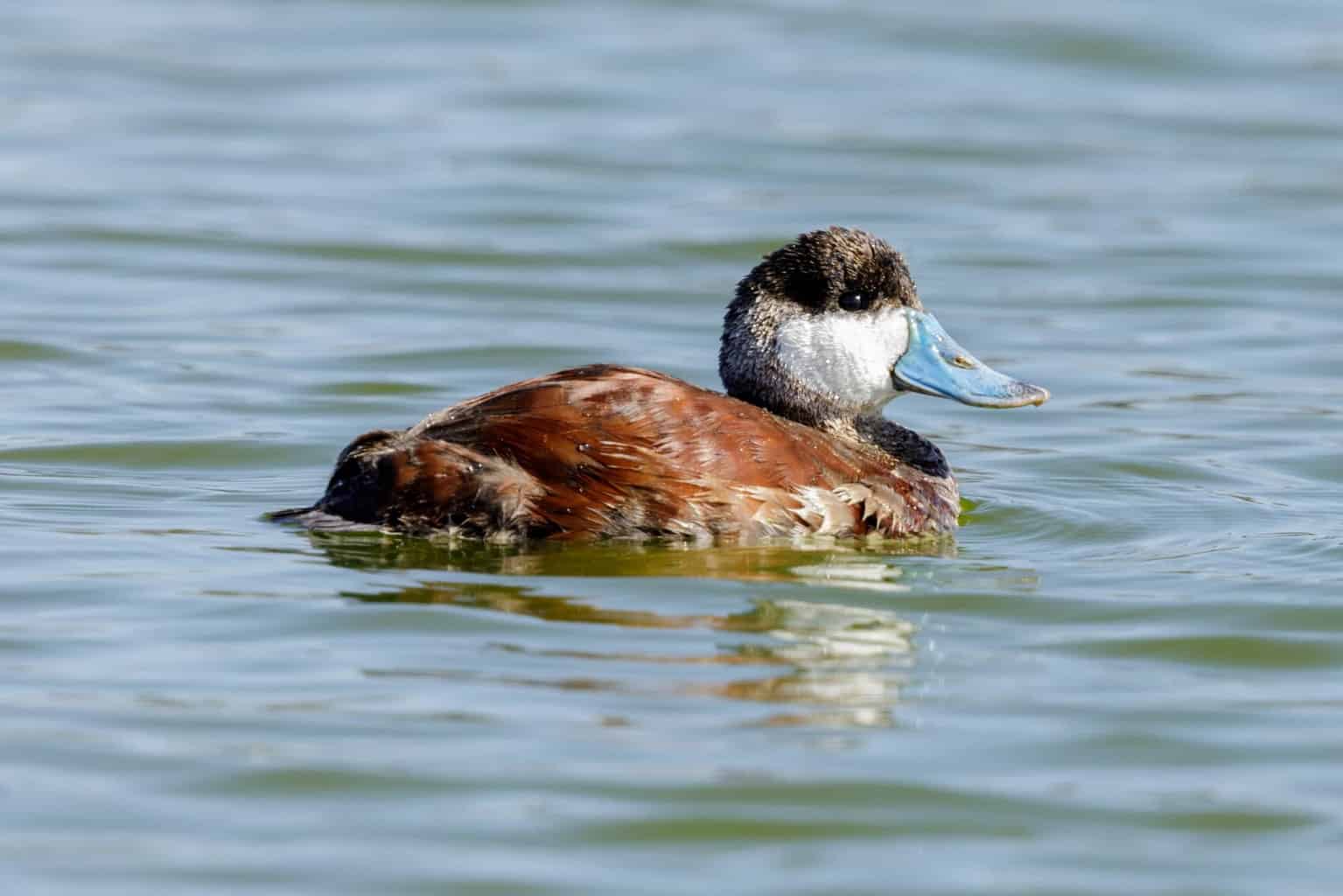
- Oxyura jamaicensis
- Length: 14 – 16 in (35.56 – 40.64 cm)
- Weight: 28.04 oz (795 g)
- Wingspan: 21 – 24 in (53 – 61 cm)
The male Ruddy Duck is gray and dull in the winter, but vibrant reddish-brown in the breeding season. In Oregon, you’ll have the chance to see both of these color patterns, as they are year-round residents.
Male Ruddy Ducks also have a black cap, a large white patch on each cheek, and a thick, broad blue bill. Females have a brown body, brown cap, and pale gray cheek patch. Their bill, equally as broad as the male bill, is black instead of blue.
As year-round residents in Oregon, Ruddy Ducks can be found in different habitats, dependent upon the season. In the summer, they’re more likely to be found in fresh water, such as marshes, ponds, and lakes. In the winter, they stick to shallow bays and estuaries along the coast.
Ruddy Ducks may lay a few eggs in the nests of other females, but they also build their own nests and raise their young.
Surf Scoter (Diving Duck)
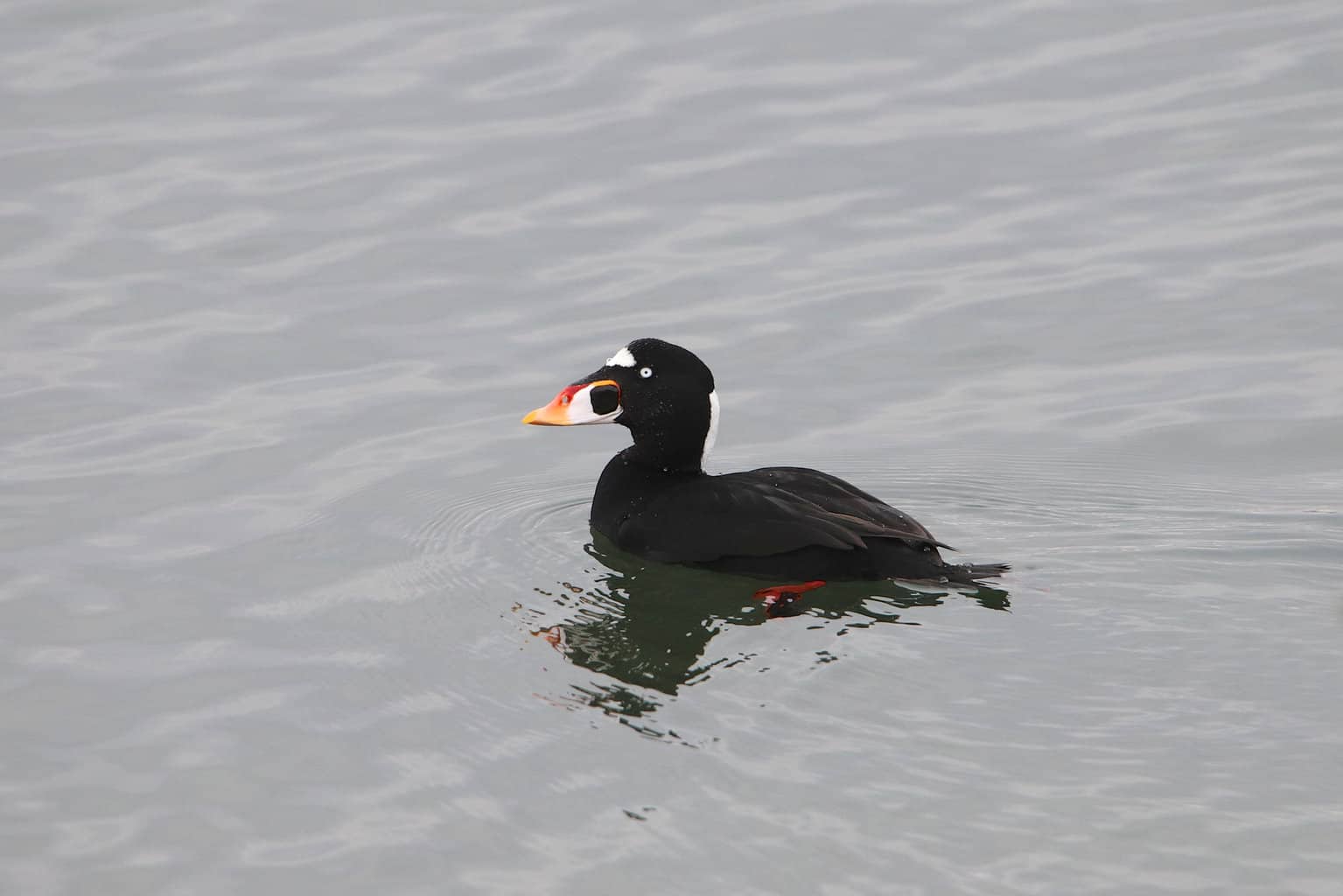
- Melanitta perspicillata
- Length: 17 – 21 in (43 – 53 cm)
- Weight: 35.27 oz (1000 g)
- Wingspan: 30 – 36 in (76 – 91 cm)
The male Surf Scoter has a pretty cool bill. It is big and orange with red, white, and yellow portions, as well as a big black spot at the base.
He has white eyes and a mostly black body, save for a white spot above his bill and another on the back of his neck.
Females are dark gray and have the same patch on the back of the neck, plus another patch behind the eyes. The female’s bill is large, too, but smaller than the male’s, and it lacks such intense color patterns. Instead, it is dark gray.
Surf Scoters eat a diet primarily made up of freshwater crustaceans, aquatic insects, fish, worms, and echinoderms.
They can only be seen in Oregon along the coast, as they never venture far away from the ocean during the winter months.
They can be found along the entire Pacific and Atlantic Coasts, most frequently in shallow inlets and estuaries.
White-Winged Scoter (Diving Duck)
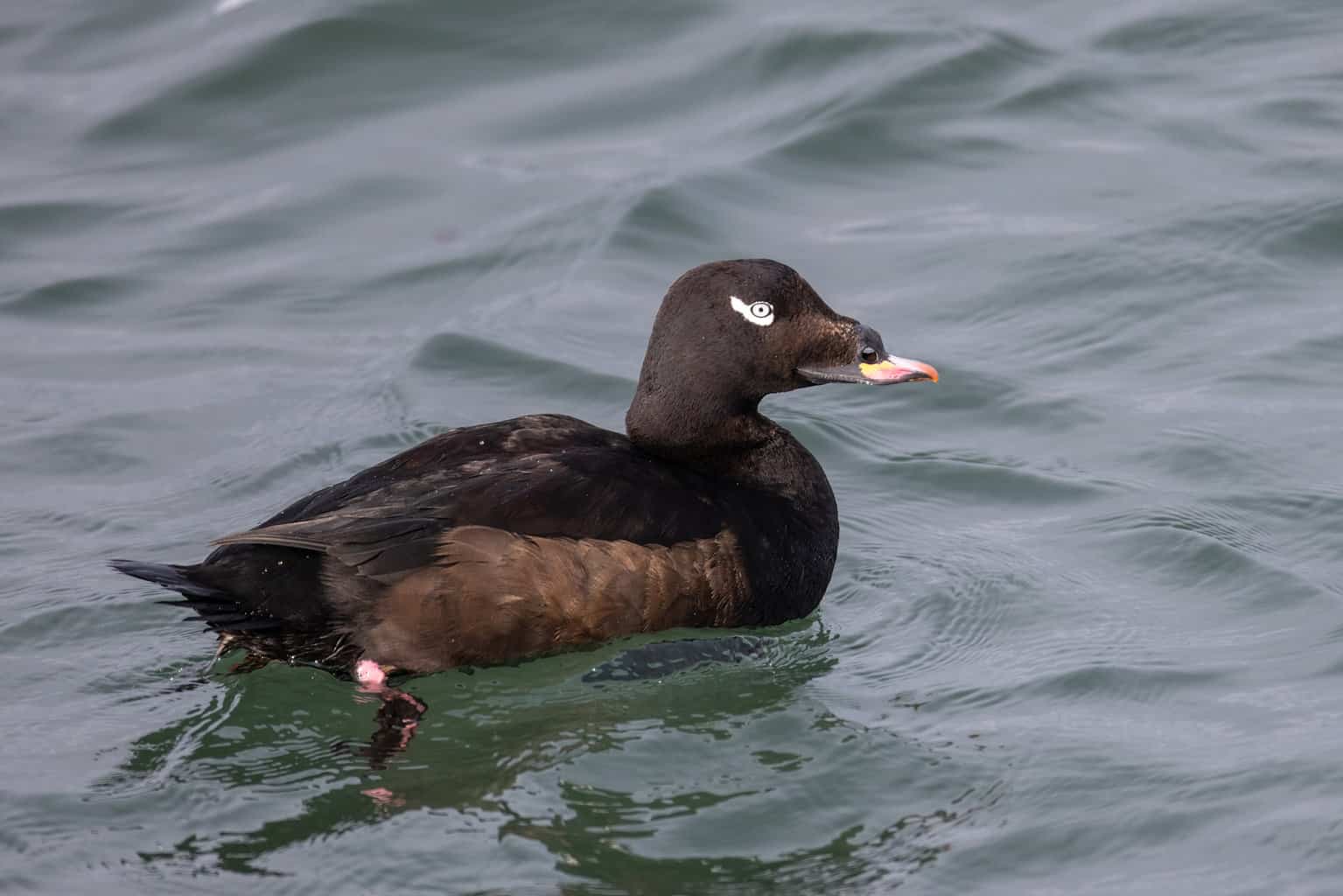
- Melanitta deglandi
- Length: 19 – 24 in (48 – 61 cm)
- Weight: 62.4 oz (1768 g)
- Wingspan: 33 – 41 in (84 – 104 cm)
White-Winged Scoter males and females are closer in appearance to one another than many other duck species. The male is dark black with a white “reverse comma” marking over his eyes and a long, white stripe down his wings.
In flight, the stripe looks like a large, white wing patch.
The female is dark brown, with a smaller white stripe down her wings. She also has two white patches on her face, one right in front of her eyes and one right behind her eyes.
Both sexes also have the scoter’s signature bulbous bill, recognizable by the knob at the base.
Although White-Winged Scoters may be spotted year-round in Oregon, they usually migrate north for the winter. They don’t stray from the Pacific Coast, and they flock together in large groups.
One interesting trait of the White-Winged Scoter is that they practice natal philopatry: they return every year to the nesting area where they were hatched.
Wood Duck (Dabbling Duck)
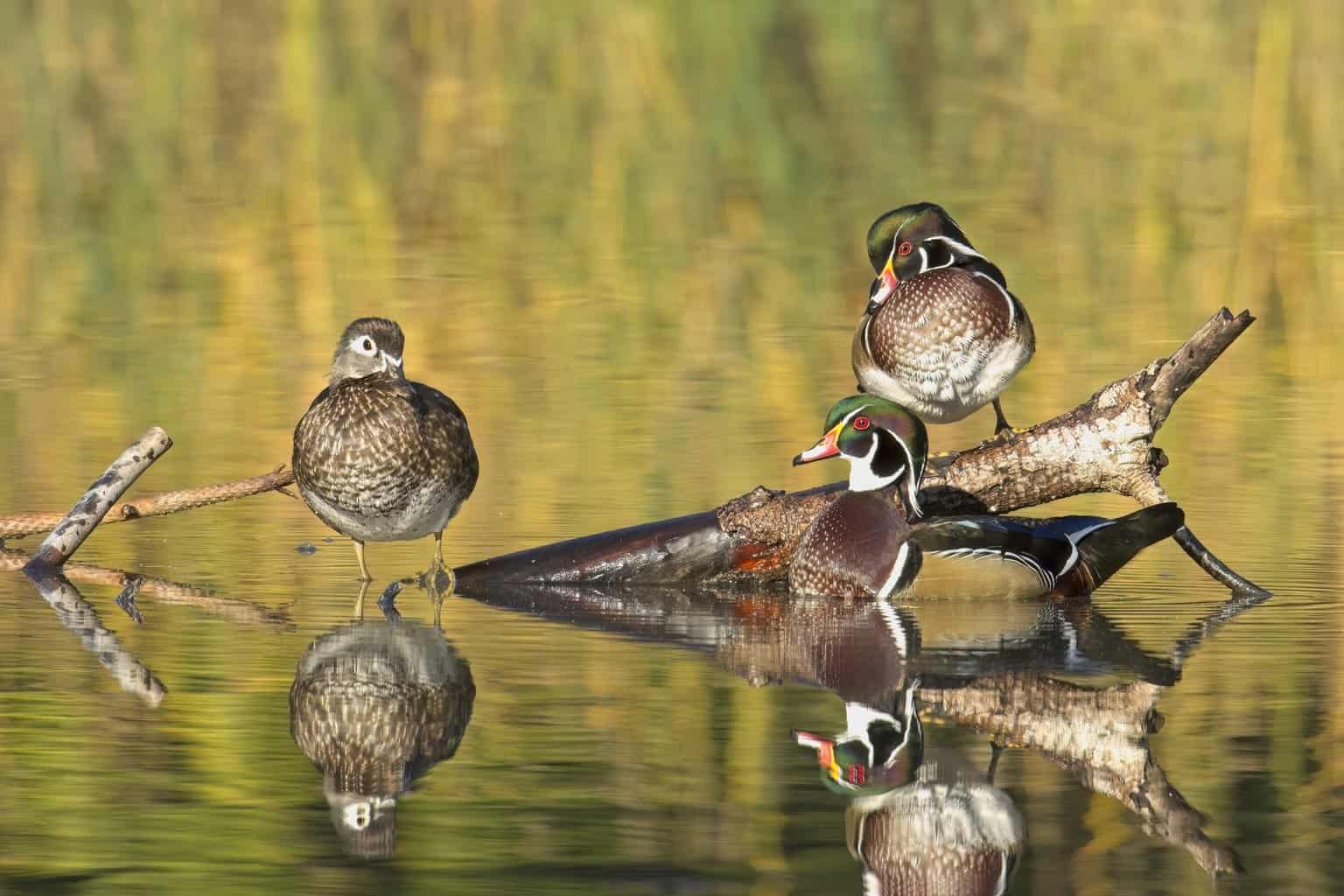
- Aix sponsa
- Length: 18.5 – 21.3 in (47 – 54 cm)
- Weight: 16.0 – 30.4 oz (454 – 862 g)
- Wingspan: 26.0 – 28.7 in (66 – 73 cm)
Wood Ducks are beautiful creatures that can be observed in Oregon all year long.
Males have stunning green heads, similar to Mallards, but with a long crest at the base of the head. They have chestnut-brown chests, buff-colored sides, brown backs, brown tails, and white markings on the body.
Females are brown, with a grayish head and a blue speculum on the wings.
Wood Ducks are cavity dwellers who choose trees that grow very close to the water. They will nest up to 60 feet above the ground.
They are year-round residents of Oregon and can be found in rivers, ponds, and swamps. Their diet is primarily seed-based and nut-based, but they also eat insects, aquatic plants, and crustaceans.
Learning to Spot Ducks in Oregon
As you can see from this list, ducks are an essential part of Oregon’s natural world. There are so many varieties that call Oregon home, either for part of the year or all year around.
These 27 kinds of ducks join the long list of fascinating birds in Oregon. With patience and curiosity, you can spot many of these ducks for yourself, whether you’re someone who lives in Oregon or is just visiting!
Watch for ducks in Oregon’s waterways and wetlands, and don’t forget to keep track of all the interesting birds you see.

